An Essay revealing Britain’s Two-Track Takeover Strategy, the Fulcrum of Language Translations & the Treaty Cliqué’s Theatre now re-packaged as sanitized Disney Treatyland Waitangi Lite
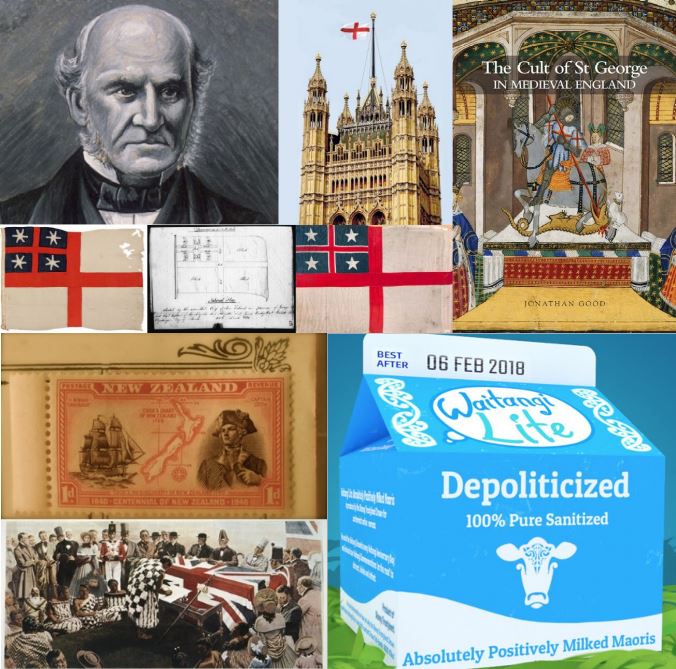
This white paper shows that two parallel tracks – a ‘Treaty Theatre Track’ and a ‘Colonial Law Track’ – were laid during the British takeover of New Zealand. Three ‘Clanker Moments’ at Waitangi prove that a Treaty Cliqué consciously avoided fully disclosing to Māori there was trickery afoot, with a Theatre production that proceeded with unseemly haste. Because the Treaty parchments spun on a fulcrum of deceptive language translation differences, the Cliqué later construed that the Treaty Chiefs had consciously and freely signed away sovereignty. Moreover, Māori at Waitangi were unaware that a secret piece of international law, known today as the Doctrine of Discovery, was applied during the 1840 Waitangi Treaty Theatre. This Discovery Doctrine was ‘transported’ on both tracks, and intersected briefly at Waitangi, where time had been weaponized to gain control over a new territorial-jurisdictional space for the British Masonic Empire. Whereas, the Colonial Law Track was the primary route through which the completion of the annexed title claimed by Freemason Bro. Captain James Cook actually occurred. Indeed, the ‘Endeavour Voyage’ in 1769-1770 was New Zealand’s first travelling theatrical production and the Waitangi Treaty Theatre was staged to distract, divide and defeat.
At the beginning of 2020, the New Zealand Crown plays an unsound, unsafe, and unwise contrived ignorance game by avoiding admission to the nation that Māori rangatira did not sign away sovereignty to the British Crown in 1840, despite the findings of the Ministry of Justice’s Waitangi Tribunal in 2014. In playing this contrived ignorance game, the Crown avoids admission to a grand Treaty Truth-out Show because it has invested heavily in covering-up Britain’s two-track takeover strategy, the fulcrum of deceptive language translations and the Treaty Cliqué’s Theatre to sell Captain Hobson’s ‘One People’ Snake Oil. This investment resulted in the Key and English ministries re-packaging the ‘Myth of Cession’ as a sanitized Disney Treatyland Waitangi Lite, which the Ardern Coalition Ministry markets at its own peril. The Māori Renaissance has cultivated confidence, resourced rūnanga and spirited solutions that aspire to forge self-determining communities based on Māori land tenure. Meanwhile, the Crown’s contrived ignorance game assumes the days of its sole sovereign power status have not been numbered with a countdown.

“Kua mau tātou ki te ripo. Kāti ka taka ki tua o te rua rau tau ka tū mai te pono ki te whakatika i nga mea katoa”.
“We have been caught in a whirlpool. Alas, it will last for beyond 200 hundred years when the truth will stand to put everything right”. – Prophet Papahurihia after the signing of Te Tiriti o Waitangi, 1840i
The Snoopman
Crown Contrived Ignorance about Mowing Over Native Sovereignty in 2020
New Zealand’s Government continues to refuse to admit that Māori chiefs did not wittingly cede sovereign power in 1840 – and is, therefore, in breach of section 240 of the Crimes Act, which deals with crimes of deceit.ii
This breach of section 240 of the Crimes Act occurs because the Crown continues to ignore the findings of the Waitangi Tribunal’s October 2014 report, that Ngāpuhi and other Treaty Chiefs did not cede sovereignty in 1840.
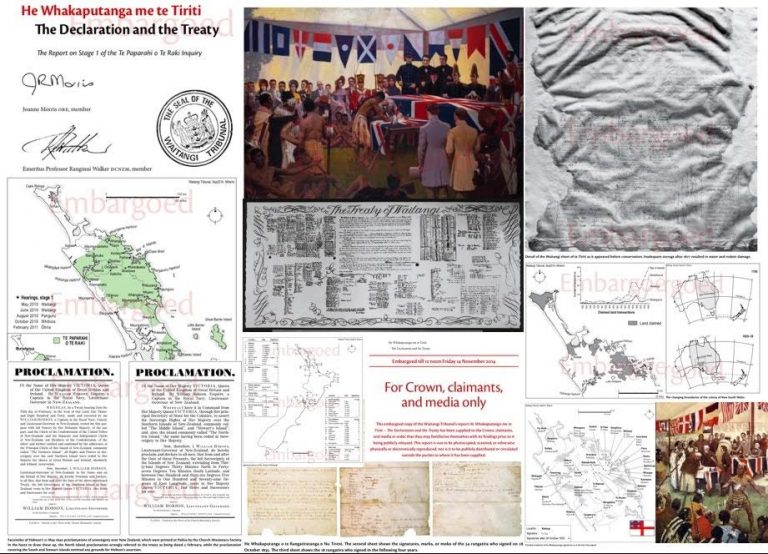
The key finding of the Ministry of Justice’s Waitangi Tribunal was that the Ngāpuhi Treaty Chiefs believed they were conferring Queen Victoria the right to appoint a governor to rule over Pākekā, and, therefore, did not wittingly sign away their mana and tino rangatiratanga, or sovereign powers and authority.iii Both mana and tino rangatiratanga were regarded as paramount, spiritually sanctioned, inalienable power, as Emily Blincoe noted in her 2015 Victoria University Faculty of Law paper, “The Myth of Cession: Public Law Textbooks and The Treaty of Waitangi”, which found that leading New Zealand law textbooks mislead law students by advancing the cession by treaty narrative.iv Not only did the Waitangi Tribunal explore the meanings ‘lost in translation’ between the English and Māori language versions of the Treaty of Waitangi. The Ministry of Justice’s Waitangi Tribunal also noted the crucial assurances of Lieutenant-Governor Hobson, his agents and the Protestant missionaries – given to rangatira: (1) Queen Victoria would not dispossess Māori of their lands they did not willingly sell; (2) Māori would not become enslaved; and (3) rangatira would still retain their chiefly authority.v
From October 2014 to October 2017, the Key and English Ministries pursued a deceptive exclusionary black-balling strategy to distract, divide and defeat Ngāpuhi and other Northland iwi and hapū, in order to avoid acknowledging that the Waitangi Tribunal’s October 2014 report – was correct in finding that there was no cession of sovereignty in 1840.vi
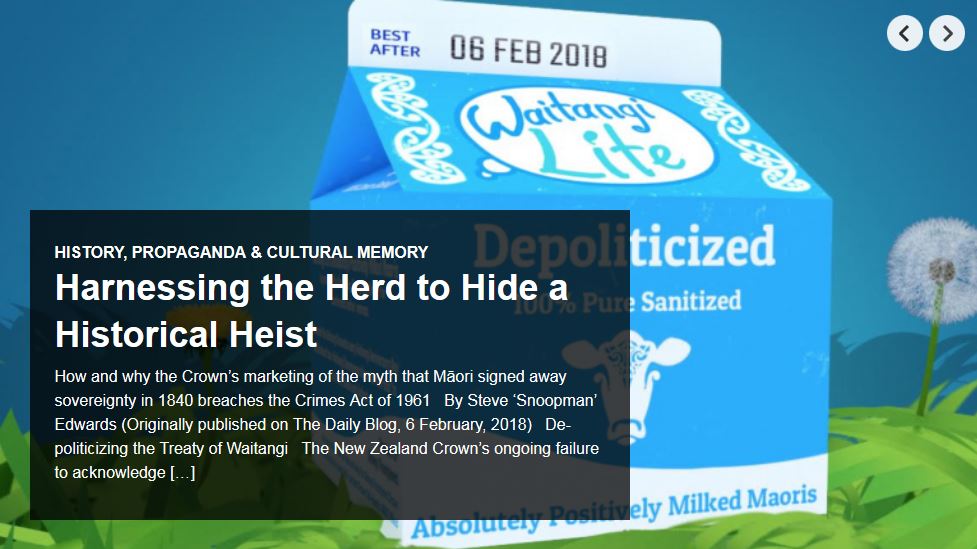
To this end, NZ PM’s, John Key and Bill English, boycotted Waitangi in 2016 and 2017, respectively, after hosting the signing of the Trans-Pacific Economic Bloc Treaty two provocative days before Waitangi Anniversary Day 2016, in order to scapegoat Te Tii Marae. The subversive objective was to de-politicize Waitangi Anniversary Day, attack the mana of Ngāpuhi to coerce the Northland iwi to cede sovereignty by settling with the Crown, and corporatize the tribes of Northland through the activation of this malicious scape-goating mechanism – as The Snoopman showed in a two-year investigation, “Harnessing the Herd to Hide a Historical Heist” – first published on Waitangi Day 2018.vii

Today, the New Zealand Crown denies New Zealanders, including indigenous Māori, the right to full disclosure, not only about the stealthy application of the Discovery Doctrine by the British 250 years ago, when Freemason Captain Bro. James Cook recorded he claimed possession in two places on the Endeavour Voyage. But also, the New Zealand Crown continues to pursue the unlawful, unsound and unwise course set by the Key Ministry when then-Treaty Negotiations Minister Chris Finlayson, Prime Minister John Key and others, whom opted to ignore the Waitangi Tribunal 2014 report, as well as Ngāpuhi’s own commissioned field study, Ngāpuhi Speaks.
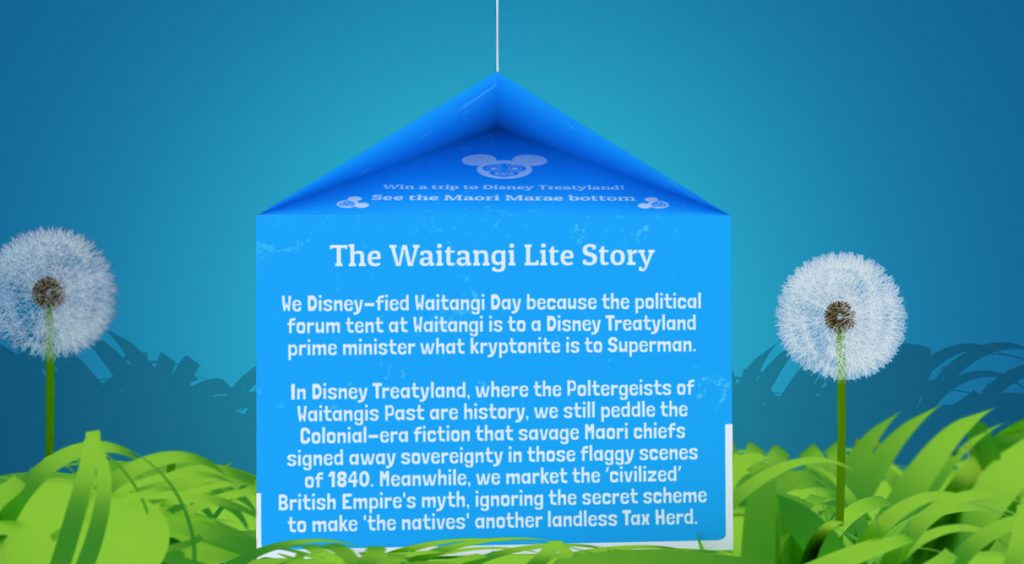
This fiction that the Treaty Chiefs ceded sovereignty to the British Crown in 1840 continues because the Crown wishes to sustain its outsized sole sovereign power over Māori. If the Crown were to very publicly admit that cession by treaty is a myth, and explain – with full disclosure – the how, the who and the why exactly, that the Treaty Theatre worked in tandem with a parallel Colonial Law Track, then it would face significantly diminished power. Given the Crown’s continued course of reckless contrived ignorance about the ‘Myth of Cession’, it is no small wonder that the Ardern Coalition Government invited Prince Charles to visit in mid-November 2019. The Royal visit to New Zealand by the neo-feudal billionaire, The Prince of Wales, and The Duchess of Cornwall, is shown to be a charm offensive, crisis intervention, and legal exercise to maintain the hereditary rights of the British Monarchy over the Realm.viii
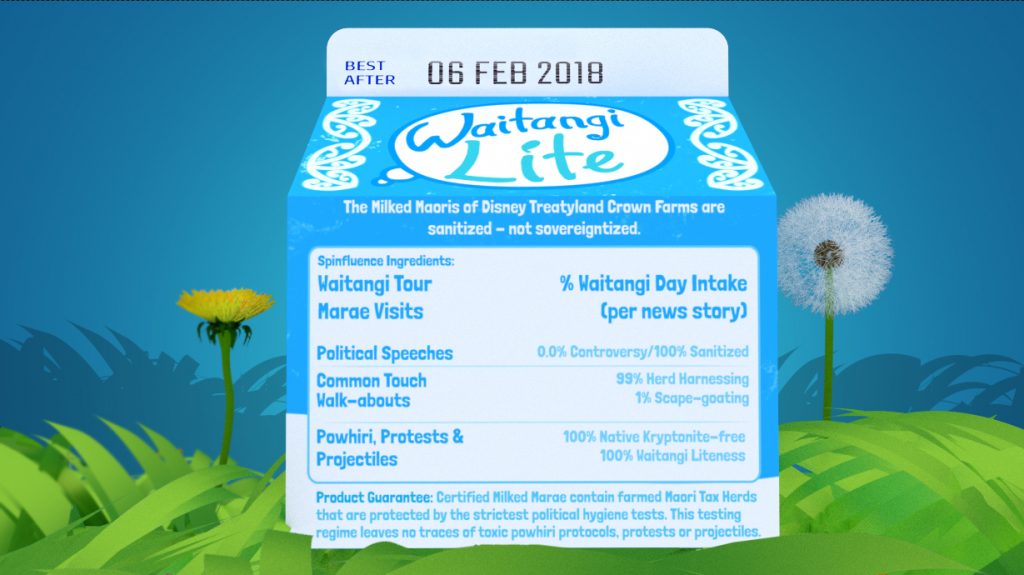
The New Zealand Crown has recklessly contrived its own ignorance by pretending it does not know about the British Crown-scripted Myth of Cession. The Government’s game of pretend means it also avoids ‘fessing-up’ to the power crimes inherent to the British Masonic takeover of New Zealand.ix
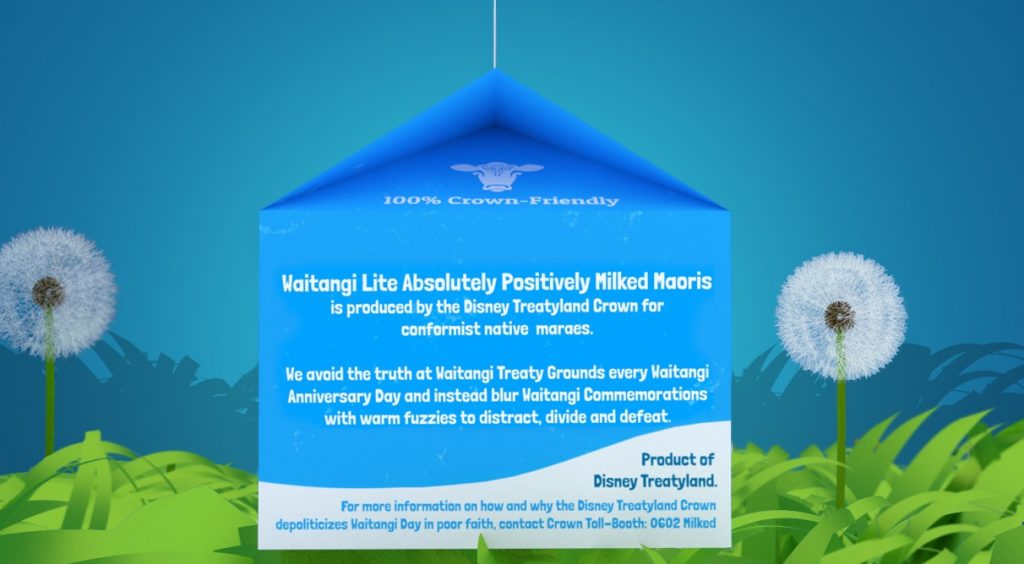
By avoiding the Waitangi Tribunal’s report – “He Whakaputanga me te Tiriti: the Declaration and the Treaty” – the Ardern Administration has, in essence, performed screening acts that ‘fail to see’ Māori were cleverly, callously and conspiratorially swindled out of possessing jurisdiction powers over their ancestral spaces – in perpetuity – with pieces of paper, pens and presents, as this investigation shows.
Screening actions are intentionally performed to avoid looking, whether institutionally, or individually, and when deftly executed at the right moments, they can very effectively sponsor subsequent unwitting misdeeds, as David Luban discussed in his 2007 book, Legal Ethics and Human Dignity, and as he modelled for his paper “Contrived Ignorance”, published in The Georgetown Law Journal in 1999.x Luban proposed viewing the version of the self that wittingly performed screening actions to preserve his own oblivion as the principle actor, while the agent is the later self at the time of the unwitting misdeed, who effectively ratifies the earlier self’s choice to compartmentalize, or screen off, potential knowledge of wrongdoing. Luban argued the case for modelling the, “Structure of Contrived Ignorance” by viewing screening actions and so-called unwitting misdeeds as a unitary whole rather than separated by time-frames.
In making his point that, “in criminal law, willful ignorance is ground for conviction, rather than acquittal,” Luban was in essence, laying out the gaps in catching and convicting group enterprises that contrive ignorance. A quote he draws from a U.S. trial seems apt for this case study of British Colonial state formation in a New Zealand context: “Ostriches … are not merely careless birds.”
Luban’s model for contrived ignorance can be used in the contemporary period to catch and convict individuals, institutions and inter-group networks contriving their ignorance to avoid admitting that the Treaty Chiefs were tricked into marking or signing the 1840 Treaty sheets, so that the British Crown could construe that sovereignty had been ceded voluntarily and wittingly.
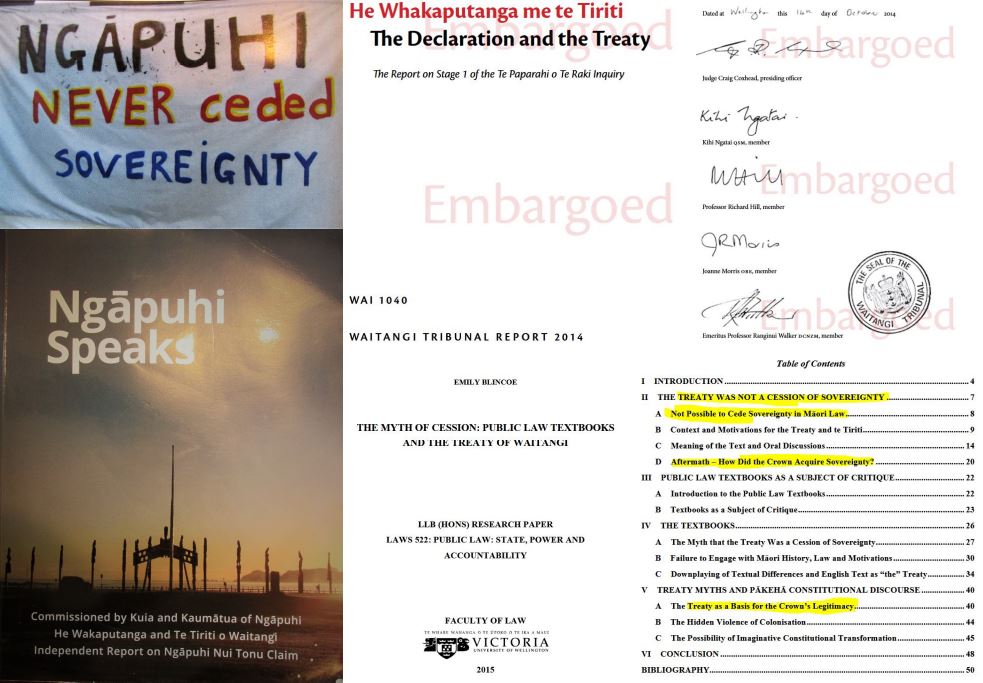
By such contrived pretenses, those screening actions of failing ‘to see’, actually ‘author’ subsequent unwitting misdeeds, such as another iwi and hapū being coerced to behave accept the Crown’s captivity at the end of long drawn-out proceedings spanning many years. Because the Fourth Estate Media cartel acts like the Crown’s sale and purchase agents selling amplified problems blown out of proportion and neatly packaged highly restricted solutions, this serialized show called ‘the news’ works to brainwash their audiences in order to protect the other three estates. In the Realm of New Zealand, the Four Estates refer to the legislature, administration, judiciary and the journalism. This idea of estates of the realm is derived from the French Ancien Régime when Christendom was the ideological framework that dominated Europe. In feudal kingdoms, the realms were divided into three broad orders as systems of social control. The clergy comprised the First Estate, above which sat the Absolute Monarchy, while the nobility formed the Second Estate as a magisterial class ministering over royal justice and civil government, and the bourgeoisie and peasants comprised the Third Estate.
In Neo-Feudal New Zealand, most serf-level Pākehā are oblivious to the Stockholm Syndrome-esque appreciation that many Pākehā Ruling Class élites expect as their entitlement in their encounters with Māori, even as their institutions play Māori with the deployment of exclusionary blackballing strategies, deflection tactics and the performance of Discovery Doctrine-embued rituals. Concurrently, the Crown seeks to avoid a noisy-amplified discussion about how exactly and why exactly private land buybacks became a scared cow issue, and therefore, the N.Z. Government to maintain its institutionally racist, structural stonewalling machinary of state – as The Snoopman showed in “Fraught Precedents for Land Buy-Backs”.

This racist, criminal and repugnant status quo means the bulk of the brainwashed New Zealand people fail to realize the Neo-Feudal Crown’s game is to remain the sole sovereign power of this Neo-Feudal Realm. Meanwhile, it is transformed into a ‘Switzerland of the South Pacific Utopia’ for centimillionaires, billionaires and trillionaire transnationals to exploit cheap labour, treat as a test lab and transform into a foreign currency ‘blood funnel’ for giant banking squid.
This brainwashing works as a short-circuiting mechanism that prevents Tauiwi New Zealanders – including those Pākehā whom have been conditioned to be racist – from seeing that a Māori people resourced with sovereign land titles, would be a bulwark to prevent everyone else getting screwed by the Pākehā-dominated Neo-Feudal Rich-Lister Oligarchy, their Pākehā Ruling Élites and their land-grabbing international Investorati.

In the rest of this white paper, The Snoopman proposes to identify a Treaty Cliqué responsible for the British takeover of paper sovereignty in the period leading up to, during and in the immediate aftermath of ‘The Great British Waitangi Treaty Swindle’. He applies power crime theory to identify those who would be liable for prosecution if this vampiric conspiring group enterprise had not already joined the ‘Realm of the Undead’. Élite criminals exploit the speed of high-velocity engineered events to distort perceptions about the facts of events that overtake “low velocity political deliberation and public accountability”, as Monash University senior lecturer of public international law Eric Wilson has found in a contemporary context in his studies of ‘Shadow Government’ phenomena. It is in this way, that “politics ‘disappears into aesthetics’ ” – as Wilson puts it.xi The supposition presented here is that the Treaty Cliqué weaponized the one physical dimension they could control, as they raced toward the endgame to capture new political space via a sovereignty payload: time.
In his paper “The Phoenix Cycle: Global Leadership Transition in a Long-Wave Perspective”, Joachim Karl Rennstich drew upon Giovanni Arrighi’s metaphor of ‘track-laying vehicles’ in this 1994 book, The Long Twentieth Century: Money Power, and the Origins of Our Times. Arrighi described how the modern world system was constructed by public state and private enterprise complexes that activated ‘switches’ to new ‘tracks’. Rivalrous major powers invent new tricks to gain supremacy. Therefore, this paper “Paper Sovereignty Swindle in 1840 & the Crown’s Contrived Ignorance in 2020” looks at the 1840 Waitangi Treaty clustered events as part of a broader innovation of trickery – treaties with indigenous peoples – and with a novel twist of swindling full sovereignty by doing so in the language of the imperial power, while full sovereignty was retained in the native language version.
Therefore, the key omissions the 1840 Waitangi Treaty texts, rhetoric and context are located in power crime theory to identify the Treaty Cliqué. In the next section, ‘British Takeover by Two Parallel Tracks’, The Snoopman shows how a ‘Colonial Law Track’ and a ‘Treaty Theatre Track’ – were laid during the British takeover of New Zealand.
The supposition explored in this white paper is that Māori chiefs, hapū and iwi were manipulated by the British through incremental steps along a track to treaty, in which they were led to believe that by their own agency in such steps that they would retain their mana and tino rangatiratanga, or sovereignty authority, as self-determining people. In other words, a long-game was played, where time was ‘quickened’ around such events so that the British side achieved their objectives at every incremental step through this periodically sped-up dimension, by weaponizing dawn to dusk until the job was done and dusted.
British Takeover by Two Parallel Tracks
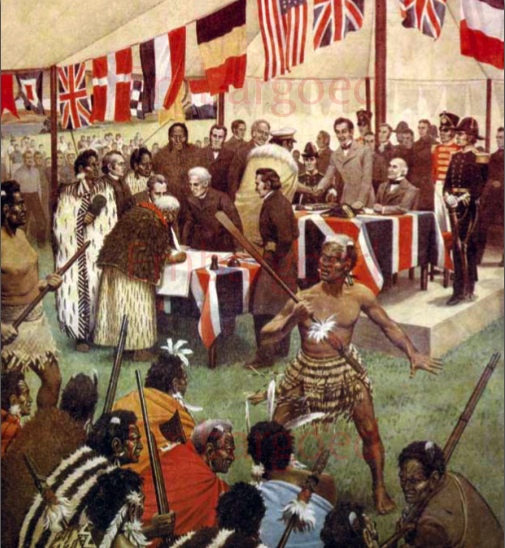
It turns out, two parallel tracks – ‘Treaty Theatre Track’ and a ‘Colonial Law Track’ – were laid during the British takeover of New Zealand. The main trunk line of the Colonial Law Track was laid in 1839 and 1840, with the roll-out of legal instruments prior, during and after the hasty hawking of the nine Treaty parchments around New Zealand coast-lines to swindle to 527 Māori rangatira and 13 wahine signatures and marks. The legal instruments included proclamations, new commissions, swearing-in officials, letters patent, legislation, gazetted notices and a royal charter that solidified the establishment of New Zealand as a separate colony of the British Masonic Empire.
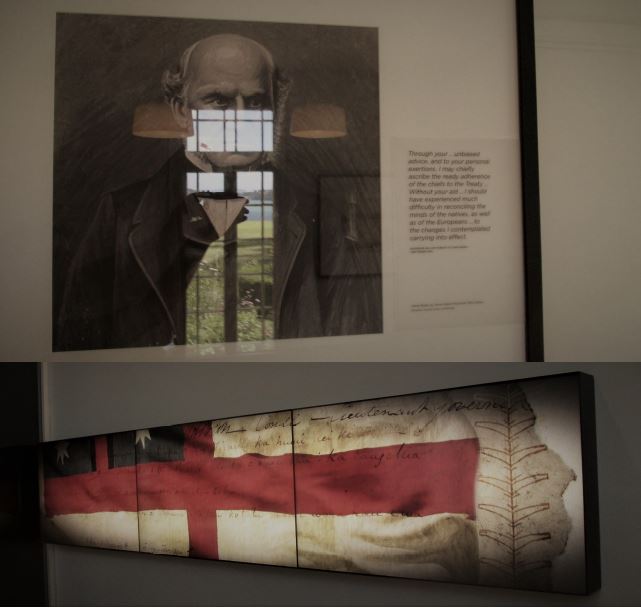
The Treaty Theatre Track began in June 1831, when James Busby outlined a policy he published in England, titled “Brief Memoir Relative to the Islands of New Zealand”, in which he wrote his dream job description as future British Resident with the power to make treaties with Māori. This Treaty Theatre Track advanced on October 5th 1831 with a letter signed by 13 rangatira asking King William IV for his protection. The ‘apparent’ joint British Resident-rangatira initiative for a National Flag for Shipping in 1834, his subsequent goading of Chief Rete, by interfering with the rangatira’s hapū’s logging trade, which led to the precedent-setting punishment that was New Zealand’s first British-inflicted land confiscation. This track to the treaty was advanced with the 1835 ‘Declaration of Independence of the United Tribes of New Zealand’, creating the edifice of an ‘independent state’. More Treaty track was laid was by Captain Hobson’s Factory System plan of 1837 which proposed a treaty for settlements. All of which culminated in the 1840 Te Tiriti o Waitangi, accompanied by its evil English language non-identical twin. The Treaty Signing Rituals served to defuse Māori resistance by tricking the Treaty Chiefs and Chieftainesses that they would retain their sovereign authority and power, while saving face for the British Parliament.
Treaty Theatre Track – From Busby’s Dream Job to Te Tiriti o 1840
In Beyond the Imperial Frontier: The Contest for Colonial New Zealand, the historian Vincent O’Malley stated, “Busby’s role as an agent of socio-cultural and political change among the northern tribes” had escaped the scrutiny that his machinations deserved. In the chapter “Manufacturing Chiefly Consent? James Busby and the Role of Rangatira in the Early Colonial Era”, O’Malley wrote:
“from the outset Busby had set about challenging existing northern leadership and governance structures in his efforts to manufacture a more centralised form of government, open to his ready manipulation on behalf of the British Crown.”xii
Tellingly, in a letter to his brother, Alexander, James Busby explained he intended to gain “almost entire authority over the Northern part of the island” by developing ties with rangatira – as O’Malley recounted.
Busby was likely advised by the Protestant missionaries of the Church Missionary Society that his objective to construct a Confederacy would only succeed if the chiefs believed they were authors of such collective action – as Samuel D. Carpenter found his 2009 report – Te Wiremu, Te Puhipi, He Wakaputanga Me Te Tiriti Henry Williams, James Busby, A Declaration And The Treaty commissioned by the Waitangi Tribunal.xiii Busby assumed Māori had never conceived the ‘idea of confederating for any national purpose’ and he believed the New Zealand to be territories of tribes whose independent-minded chiefs could be lured into forming the appearance of a national government. In the field-study, Ngāpuhi Speaks, commissioned by Kuia and Kaumātua of Ngāpuhi asserted that the Northern Alliance chiefs had maintained a custom of gathering known as Te Wakaminenga that dated back to 1808, following the Ngāti Whātua victory over Ngāpuhi in the Northland battle of Moremonui at Maunganui Bluff, in 1807, at the beginning of the Musket Wars (1806-1845). Other issues arising from European contact were also discussed including international trade, land loss and challenges to tikanga. These Te Wakaminenga gatherings, which are referenced in Article One of the Māori language He Whakaputanga o 1835, did not usurp or over-ride hapū autonomy, and if there was consensus reached, the agreements were not binding – the ground-breaking Ngāpuhi Speaks study found.
In June 1831, James Busby outlined a policy published in England as a “Brief Memoir Relative to the Islands of New Zealand”, in which he wrote he a job description for a magistrate to live among Māori. Busby proposed to acquire a modest piece of land by contracting with the chiefs, be empowered to make treaties with rangatira, and set up a trade prohibition to exclude Europeans from such a district.xiv
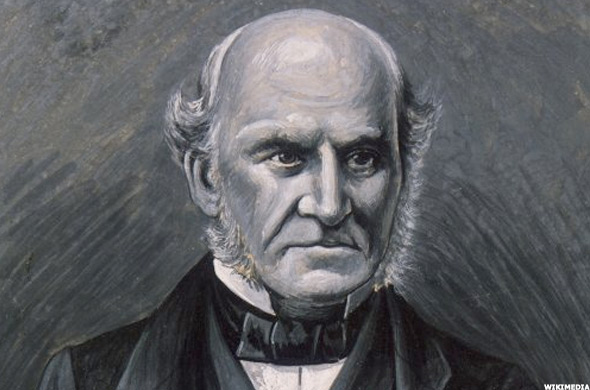
Later in 1831, a letter of petition that was signed by 13 Māori chiefs by way of moko drawings, to King William IV asking for the King’s protection.xv The petition of October 5 1831, which was likely drafted by William Yate and Eruera Pare Hongi, has the clear hand of the Protestant missionary’s agenda. In September 1831, a rumour had spread that a French ship was coming to invade and evidently caused much alarm in the Bay of Islands, and several rangatira approached Reverend Henry Williams to seek protection from King William IV. A French corvette, La Favorite, arrived on October 3. The ‘Letter to King William IV’ emphasized the concern of Māori chiefs who had been manipulated into thinking ‘the Tribe of Marion’ (the French) is at hand, coming to take away our land.”xvi
In an oral and traditional history report, “He Rangi Mauroa Ao te Pö: Melodies Eternally New”, Associate Professor Manuka Henare, Dr Angela Middleton and Dr Adrienne Puckey, state that ‘Northern Māori oral tradition … does not record any alarmist tendency from among Māori about French intentions to take over the country’.xvii This 600-page report, which was received by the Waitangi Tribunal in 2013, frames this event as a continuation of ‘a dialogue of equals’, in this case between the thirteen signatories – Wharerahi and Rewa (Patukeha), Te Haara, Patuone and Waka Nene (Ngāti Hao), Kekeao, Titore, Tamoranga, Matangi, Ripe, Atuahaere, Moetara and Taunui – and King William IV.
However, this ‘dialogue of equals’ is bunk rhetoric that short-fuses critical thinking circuitry.
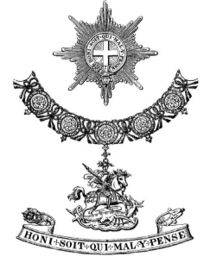
For one thing, William IV was the Sovereign Head of the dynastic English Order of the Most Noble Order of the Garter, which is England’s most prestigious and dynastic order. The Order of the Garter was founded in 1348, by King Edward the Third eleven years into the Hundred Years’ War fought over the Kingdom of France, and marked the decline of feudalism and the rise of nationalism. This Order of the Garter features the St George’s Cross, St George and the Dragon, and not surprisingly, given the Cult of St George, this legendary character is the patron of all knighthoods, according to Orders and Decorations, written by Václav Měřička. Indeed, new knights are often announced on St George’s Day. The Royal Monarch always becomes Sovereign Head of the Order upon ascension to the British Throne, which is located in the British House of Lords in Westminster City.
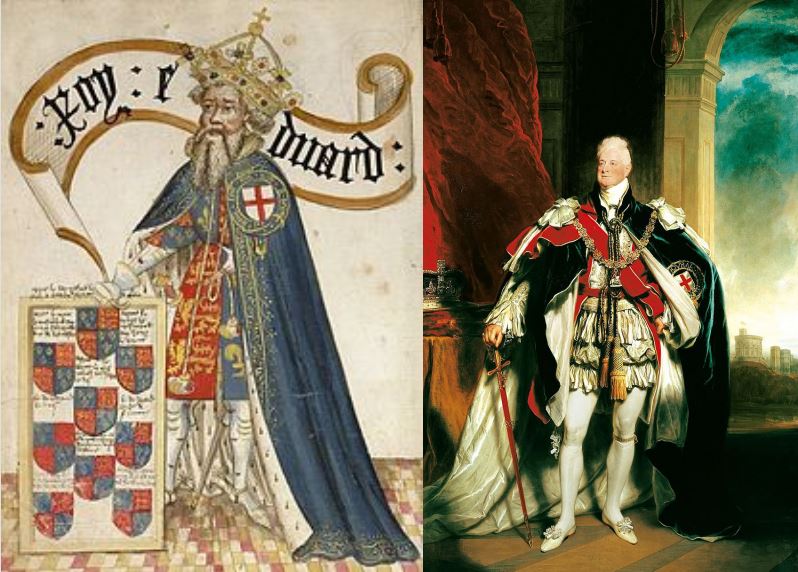
Meanwhile, in a letter dated November 10th 1831 that Busby wrote from London to his brother, N.Z.’s future British Resident proposed that he become “the authorised agent of the British Govt. in treating with the Native Chiefs [of New Zealand] for the Mutual protection of their own people and of the Europeans…”xviii In March 1832, Busby sent his Brief Memoir Relative to the Islands of New Zealand to the Secretary of State for War and the Colonies of Britain, Lord Viscount Goderich, in which he hinted at French designs to takeover New Zealand and also of Russian interest in the archipelago. With the support of missionaries, and the favourable impressions he made on the Colonial Office, helped along with a tasty bribe of 40 bottles of wine produced at his vineyard in New South Wales, Busby was awarded the post as British Resident.xix Busby would be afforded the protection from Vice-Admiral of the Indian Squadron, Sir John Gore, who was ordered to deploy ships to visit principal harbours of New Zealand as frequently as possible.xx This protection was symbolic, since the ships would simply act a presence to remind all foreigners that the Royal Navy were the water police of a transmarine empire.
The response attributed to King William’s ‘mind’ came through a letter written by the high-ranking Secretary of State, Lord Viscount Goderich, who feigned to accept the rangatira communiqué of “friendship and alliance with Great Britain”. This letter carried the same date, 14 June 1832, as Goderich’s instructions for the British Residency appointment. Busby had suggested an audience with the King before his departure with the idea that it would elevate his esteem in the eyes of the chiefs. This idea was rebuffed. The logic of power suggests it would not suit the British Empire’s long-game to have the King so directly endorse their point-man for reeling in their big catch, with so little expended in fishing tackle and bait. It was this letter that Busby read on his arrival to a gathered audience of rangatira. After-all, rangatira had been led to believe that the encounters between chiefs Hongi Hika and Waikato with King George III in 1820 signified the beginning of this ‘dialogue of equals’, rather than of two big fish taking the bait on two hooks of a very long line.
By the time of his arrival in Peiwhairangi, the Bay of Islands, on May 5th 1833, Busby was “resolved to bend the whole strength of my mind to effect this object” toward a Confederation of Chiefs.xxi After twelve days of badly behaved weather, Busby came ashore and read Goderich’s letter to an audience of 22 high ranking rangatira and more than 600 other Māori.
By exquisite serendipity, New Zealand’s first British official learned of the woes of Māori shipping before departing for New Zealand at Port Jackson, Sydney, from a ship owner Joseph Hickey Grose, who sought his help to get his impounded ship registered. Customs Authorities had a ship, the New Zealander, impounded in January 1833 for failure to be registered as a trading vessel and to fly a national flag.xxii This incident followed the November 1830 impounding of the Sir George Murray, with the Hokianga high chiefs and part-owners, Patuone and Te Taonui, on board.xxiii Because New Zealand had become a foreign territory to the Colony of New South Wales in 1823, and was not a recognized power, the indigenous-owned vessels could only be placed under the flag of a ‘friendly power’ once all the signatory chiefs’ marks were gathered and provided the ships were three-quarters crewed by ‘natives’ and then such ships could ply their wares under the Reciprocity Act.xxiv As the Waitangi Tribunal noted in its 2014 report, “He Whakaputanga me te Tiriti’:
“Busby astutely recognised that the issue provided an opportunity for him to draw the chiefs – who would probably never have contemplated ‘confederating for any national purpose’ – into working in concert. After his arrival in New Zealand, therefore, and a few days even before he was presented to Bay of Islands Maori, he outlined his plans to the Secretary of State of War and the Colonies, for the rangatira to come together and choose a national flag for New Zealand-built ships. He himself would undertake to certify the chiefs’ registration of the ships, but only if two-thirds of them agreed upon a flag design and petitioned King William to have it respected. Through this precedent he hoped the chiefs would ‘consent that they will henceforth act in a collective capacity in all future negotiations with me’, with the ensuing ‘confederation of chiefs’ providing the basis for an established Government’.”xxv
Evidently, Māori maritime commerce needed saving from the maw of the British Dragon of Maritime Traffic Infringements and it was lucky that British Resident James Busby just happened to hear of its peril while at Port Jackson. After this serendipitous encounter, Busby exploited the matter to get a national flag for Māori shipping as a cause célèbre mechanism to weld rangatira into a formalized collective federation of national purpose.
To this end, Busby cast himself as the heroic protagonist in the Cult of St George. The popular legend of St George valourizes his role as a soldier who saved a princess from the maw of a hungry dragon that won the customary right to eat sheep and children. The princess had been drawn in a ballot for sacrifice. With exquisite synchronicity, St George the Christian Knight just happened to be passing through the terrible scene. St George astutely saw an opportunity to expand the Church’s franchise and offered to save the princess on condition that the traumatized people convert to Christianity. In keeping with the legend of St George, he only does so by extracting a ‘pound of flesh’ from ‘the Natives’. In January 1834, Busby sent three flag designs, drawn by the Church Missionary Society Reverend Henry Williams, to Sydney to be produced as prototypes.

A hui was hastily called for March 20th 1834 to convene on the front-lawn at Busby’s house at Waitangi, with about 750 Māori in attendance.xxvi Busby’s design was to subvert Māori agency without the rangatira knowing the track he was leading them down. Embedded in Busby’s machinations were the gaining of submission of 26 selected principle chiefs, whom he lured to prostrate themselves to reach the exclusive cordoned off area to make their selections, by crawling under a British shipping rope inside a white make-shift ‘tent’ made of sails.xxvii Busby called the chiefs by name, whom included Waikato whom had met King George IV, along with Hone Heke, thereby creating a division “between the noblesse and the canaille (or common) of New Zealand … [causing] … no small discontent of the excluded”, as William Barrett Marshall recounted in his 1836 book, A Personal Narrative of Two Visits to New Zealand in His Majesty’s Ship, Alligator, A.D. 1834.
The Waitangi Tribunal reported the chiefs were baffled. An observer from a Royal Navy ship named after a species of tropical reptile, HMS Alligator, the Austrian Baron Karl von Huegel, noted that some chiefs queried the logic, because on the one hand, King William was said to be extending his friendship, while on the other hand they were being told the King’s men would seize their ships if they did not accede to a flag.xxviii Von Huegel recounted that the first three chiefs each chose a different flag, while the remaining chiefs, “did not care which flag was chosen”.xxix At this point, a servant of the missionaries, Eruera Pare, pressed each chief to make a choice and by this coercive method, he was able to tally up the score – according to Von Huegel’s account. The rangatira were indifferent to what was on offer. According to Busby’s own muddled speech, the rangatira were being pushed to make their preference while at the same time they were to confer with the chiefs in other parts of the country, “so that your decision would be the decision of the majority.”xxx
Twenty-eight votes were cast, with twelve votes were taken for the chosen flag, ten for the next choice and six for the third-place flag. Two chiefs abstained, “apparently apprehensive lest under this ceremony lay hid some sinister design on our parts”, as Marshall described.xxxi Marshall observed that “freedom of debate” was discouraged, since Busby invited no discussion, and he claimed a friend, called Chief Hau, evidently asked Marshall what flag was his preference. Hau subsequently voted for Marshall’s preferred flag design, with the St George’s Cross on it and apparently Hau canvassed other chiefs for their votes also. The new Te Kara flag, complete with the St George’s Cross motif, was raised on a poll next to a taller flagstaff flying the Union Jack, and a 21 gun salute was fired from the HMS Alligator followed the vote,xxxii the traditional pomp to make a sovereign and at this occasion, evidently to construct the illusion that the British were beginning to recognize the islands of New Zealand as a state.
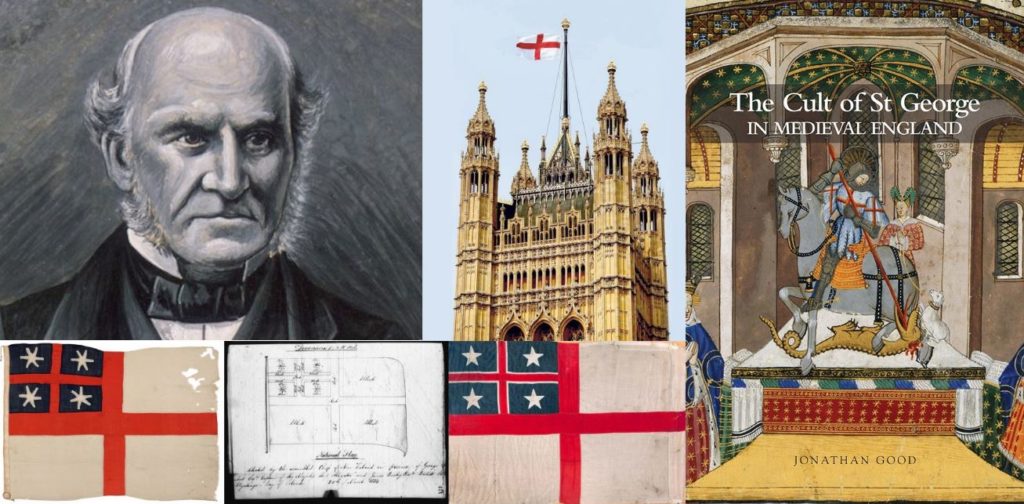
Forebodingly for Māori, Busby invited about 50 European guests into his Residency for a meal, while his Māori guests were served outside with a ‘meal’ of ‘stir-about’, which was a thin paste of flour and water. Busby had deliberately under-catered to discourage Māori from turning up in large numbers and had also sought to place his indigenous guests in a lower status by excluding them from his table, and essentially serving them children’s glue as food, or what was fed to prisoners and the homeless in England. These insults demonstrate Busby’s machinations. The rangatira were tricked into participating in a precedent-setting Westminster Parliamentary-style of voting, to select a flag design out of a slim set of three choices.
While the Europeans were dining, rangatira performed fiery speeches outside. Chief Kiwikiwi spoke:
“How have we come into this situation of having to hoist a flag on our boats to ensure our own safety? It is through our own fault that we have to do it, if we had been more united among ourselves, if we had had no enmity of one horde against another, we would have been able to oppose their landing.”
With such exquisite serendipity, and by a narrow margin, enough of Busby’s selected chiefs just happened to choose the one with the St George’s cross on it, the very same cross on the Church Missionary Society flag and which appears on the flag of England. Busby gained their conversion to the cult of British Maritime Law, with their ascent to the adoption of a national flag, complete with the red St George’s Cross motif for abundant replication and a shipping register to entangle Māori shipping. This ‘winner’ only occurred after the chiefs were pressed to pick a preference. The firing of the 21 gun salute from HMS Alligator was theatrics and the dirty details of this episode in gaming Māori were excluded from Busby’s report.
The chiefs’ ‘choice’ gets more curious when it is learned that the Templar Knights adopted the Red Cross in 1145, and French troops used it during the Third Crusade or the Kings’ Crusade (1189-1192), that was co-sponsored by Phillip II of France and Richard I of England, and and Frederick I, Holy Roman Emperor, while English troops used a White Cross in 1188 under Henry II. Philip II, William I and Count Phillip of Flanders met at Gisors in northeast France on January 13th 1188, to choose the three colours of crosses to be worn by their respective soldiers. The colour of three crosses signified which language to communicate with the troops.xxxiii George of Capadocia (modern day Turkey) or St. George, the Patron Saint of England, is venerated as a legendary champion of Truth and defender of the Christian religion.

With this chiefly ascent, Busby successfully riffed off Crusades history, by embedding the red version of St George’s Cross used by the French in the Kings’ Crusade, or the Third Crusade. Doubtless, these machinations entertained Busby greatly, particularly as this red cross was subsequently adopted by the English. Busby was, therefore, sticking it to the French, while at the same time signalling that stoking fears in Māori of France as the enemy – was actually an effective means of manipulation. In his role as ‘British Resident’, New Zealand’s first official was luring Māori chiefs to ascent to the jurisdiction of British Maritime Law, which meant Busby was formalizing the assertion of a Discovery Doctrine element known as Tribal Limited Sovereign and Commercial Rights.
The Doctrine of Discovery was a secret piece of international law that emerged during the Crusades, which targetted the ‘Holy Lands’ between 1096 and 1271, when the Vatican Empire asserted a worldwide papal jurisdiction to justify Holy Wars fought by the Knights Hospitallers, the Knights Templars, and the Teutonic Knights. Muslim Saracens were cast as ‘Infidels’ and Christians could ‘legally’ reconquer their lands by divine mandate, which limited the property rights and self-government of non-Christian peoples, to serve the diabolical ambition to forge a universal Christian empire.xxxiv The Discovery Doctrine was further developed between European nations in the 15th Century, from whence they were forging maritime empires, and was designed to mitigate the chances of competing nations making expensive war with their technologically-even European competitors at the cost of much ‘blood and treasure’. The European Maritime Powers thought it would be easier to gain territory off ‘New World’ indigenous peoples, whom were cast as ‘savages’.
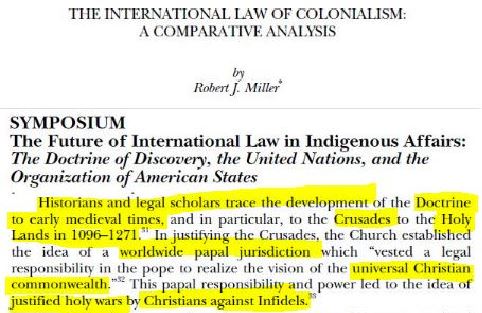
As indigenous law scholars Robert J. Miller and Jacinta Ruru stated in the West Virginia Law Review:
“When Europeans planted their flags and crosses in these ‘newly discovered’ lands they were not just thanking God for a safe voyage; they were instead undertaking the well-recognized procedures and rituals of Discovery designed to demonstrate their legal claim over the lands and peoples.”xxxv
Busby wrote to New South Wales Governor Burke:
“As this may be considered the first National Act of the New Zealand Chiefs it derives additional interest from that circumstance. I found it, as I had anticipated, a very happy occasion for treating with them, in a collective capacity, and I trust it will prove the first step towards the formation of a permanent confederation of the Chiefs, which may prove the basis of civilized Institutions in this Country.”xxxvi
The British Resident’s official correspondence was sanitized and at odds with his private words and his ‘public’ deeds.
Next, Busby antagonized a local chief, Rete, by bossing him and his hapū around about how to conduct their logging commerce. Rete was also annoyed that Busby had taken control of large tracts of land. Brazenly, Busby lobbied for Rete’s execution after the evidently insubordinate chief ransacked Busby’s storehouse,xxxvii and the British Resident copped a wood-splinter wound to his face when a musket shot hit the back-door frame, from where Busby had disturbed ‘the Natives’ one night in the midst of exacting a muru, or ritual compensation, in keeping with Māori customary law.xxxviii Because Rete’s New South Wales Governor Sir Richard Bourke permitted inflicting a retaliatory punishment. Rete’s huts were burnt and 130 acres of his village, Puketona, were confiscated and Busby renamed it Ingarani, the Māori transliteration for England.xxxix Busby later burnt down traditional fishing huts on the land he had bought when he found out that Rete and his friends had been using them. Busby has ‘allowed’ continued use of the huts by Māori, but set fire to them without notice and this action strained relations.
The incontrovertible fact is that Busby acted as an agent provocateur seeking to antagonize Chief Rete, having gained chiefly recognition of British Maritime Law. Busby’s provocation occurred after he had conned chiefs to vote for a flag of national shipping and therefore, volunteer their submission to British Maritime Law, and join in the system of international law.
Having successfully inflicted the first land confiscation with the participation of a dozen rangatira, three quarters of whom were bribed with presents, Busby then deployed his defining confidence trick: gaining chiefly participation in signing the 1835 ‘Declaration of Independence’, or He Whakaputanga o te Rangatiratanga o Nu Tirene.
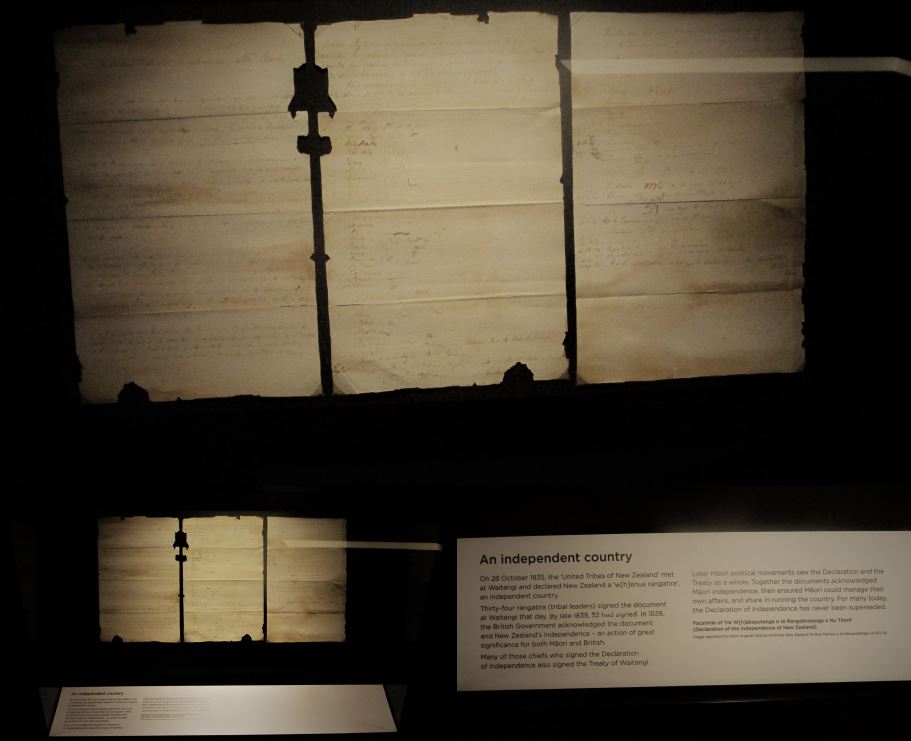
Busby stoked fears that Māori would be enslaved on the basis of a letter sent to him by a delusional Frenchman, Charles de Thierry, who claimed to declare sovereignty. Busby’s modus operandi was to turn any threat, real or perceived, into an opportunity and was part of the British strategy to game Māori.
Indeed, the origin of this ‘Declaration of Independence’ can be traced back to the ‘Letter to King William IV of October 5 1831’, which had been triggered amid widespread rumours of a French ship coming to take lands. Following the first signings of the 1835 ‘Declaration of Independence’ – 33 in all on October 28th – Busby eventually gained a full deck of cards worth of 52 chiefly marks and signatures over a four-year period, including chief Te Wherowhero.xl
In regard to whether the 1835 Declaration was Busby’s initiative, or that of Ngāpuhi rangatira, Ngāpuhi kaumātua Erima Henare challenges the credit that Pākehā historians bestow on Busby. In the Ngāpuhi Speaks report, it was conveyed that E. Henare pointed out that proof of Ngāpuhi agency in He Whakaputanga is the fact that when the iwi gathered at Busby’s residence at Waitangi in 1835 they fed themselves, while five years later, the missionaries stumped up for the food. Granted, there was clearly far more rangatira agency in the discussion that resulted in the composition of the final texts for the 1835 Declaration, than with the both versions of the Treaty, which were composed entirely by Pākehā. However, it is ultimately a fallacy of evidence to suggest that who laid on the kai for the home crew is proof of who had control of the foreign ship’s rudder carrying the dispatches, with the ‘all-important’ English versions of any letters, declarations or treaties carrying the marks of rangatira, as well as the Māori language versions. Particularly, as Busby had deliberately under-catered for the festivities following the vote for the Te Kara and creation of a shipping register on March 20th 1834, meaning he did not want to ever have to cater for Māori because he saw himself as above ‘the natives’. And because he was, in effect, conjuring more tracks and sleepers that would eventually culminate in an improvised low-speed Waitangi Treaty track section, or siding, where Māori would see the events moving past them on the faster track – creating the experience they had been caught in a ‘whirl-pool’ – like Prophet Papahurihia sensed after the signing of Te Tiriti o Waitangi.
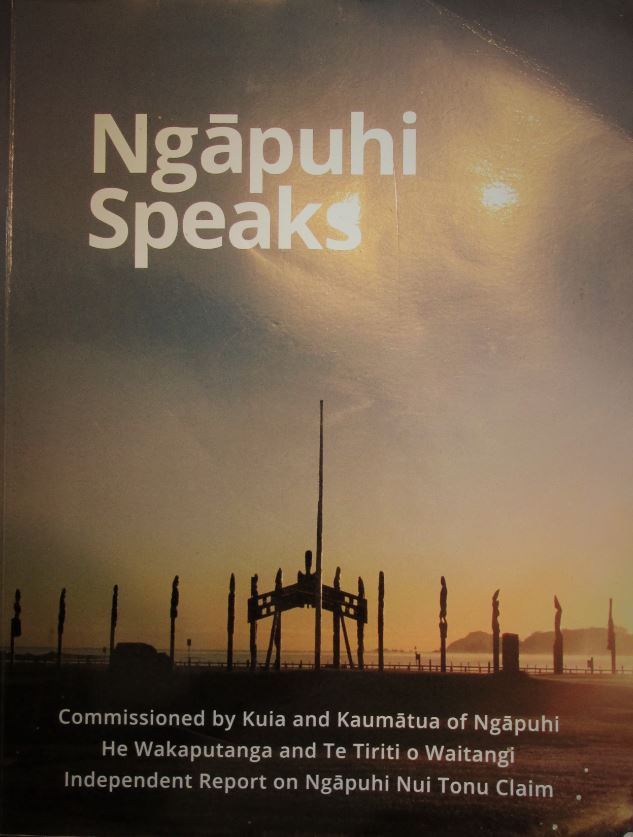
The significance of Busby’s machinations can be brought into sharper focus when it is recalled that the British Resident was shot at when he disturbed Chief Rete sacking his storehouse. In nearly all accounts of this incident, the reason why Rete was stealing Busby’s stores is omitted, thereby rendering Rete as a common thief. Even Ngāpuhi Speaks misses the full significance, despite this report recounting that Chief Rete was inflicting a muru since Busby was land speculating and threatening to stop the logging trade – as Pairama Tahere recounted.xli The writers miss the point about why exactly Busby’s first reaction on learning the identity of the culprit was to insist for Rete being executed. And omitted that the informant to Henry Williams was Ngāpuhi chief Hōne Heke Pōkai, of the same village, Puketona, whom would later surely have rued the day that he had ever performed the role of a ‘tell-take-tit’, since he was later, famously, driven to repeatedly cut down the flag-staff on the Maiki Hill above Kororāreka (Russell) in 1844 and 1845 to draw attention to the British takeover.
Ironically, Heke was no longer able to charge anchorage fees because authority had shifted to Crown’s officials and Hobson had shifted the capital from Kororāreka to Auckland, which caused significant economic decline. In other words, Heke’s rangatiratanga was being interfered with and decisions were being made without Māori. Heke had failed to care that Chief Reke had sensed his rangatiratanga was being breached by Busby and failed to see that Busby’s actions were about laying a Treaty Theatre Track. Because the muru that Reke was trying to inflict on Busby was construed as an act of theft, with the result that the Busby-Rete events cluster has been often been overlooked, the exquisite irony embedded in Heke’s flag-pole chopping has been also lost on earnest historians, Treaty scholars and Treaty workshop teachers.
In other words, New Zealand’s first British official wanted the life of the one man who was an immediate threat to his power, however limited, to be snuffed out. Because if the truth got out that he had exerted his bossiness over Rete’s business, the logic of Busby’s mindset would have been laid bare. This is why the reason for Rete’s muru, or ritual compensation, was rendered as a ‘theft’, and why – like so many crucial details in history – it was only carried in oral accounts by the ‘little people’ whom historians have a tendency to overlook. Even Anne Salmond misses this detail in her excellent, Tears of Rangi, despite her reading Ngāpuhi Speaks.
In his letters, Busby’s real attitude toward Māori rangatira is revealing. In a 16 June 1837 dispatch sent by Busby, the British Resident proposed the British Crown make a treaty with Māori and sought to persuade British to establish a protectorate government in New Zealand.xlii Busby referred to the 1835 ‘Declaration of Independence’ to explain his logic:
“that the congress of chiefs … is competent to become a party to a treaty with a foreign power, and to avail itself of foreign assistance in reducing the country under its authority to order; and this principle once being admitted, all difficulty appears to me to vanish.”xliii
Moreover, he claimed that a treaty would be regarded by the chiefs as an acquisition of power rather than a surrender of power because:
“the New Zealand chief has neither rank or authority but what every person above the condition of a slave, and indeed the most of them, may despise or resist with impunity. It would, in this respect, be to the chiefs rather an acquisition than a surrender of power.”xliv
The Māori language version known as He Whakaputanga o 1835 bestowed authenticity to the English language version since this version was derived from the te reo Māori version, which was primarily drafted by Eruera Pare Hongi.
To the British Crown, the English language version of the 1835 ‘Declaration of Independence’ formalized New Zealand as an independent state controlled by a confederacy of chiefs. It was recognized as such by the British Crown in 1836 and the British Parliament in 1838, but more accurately applied to the Northern parts of the North Island, as well as the Waikato and Hawke’s Bay. The British were able to construe that New Zealand was an ‘independent state’ – while, curiously, at the same time the entire islands of New Zealand became a protectorate of the British Crown. While family groups and tribes exercised independence, their capacity to defend themselves against the full force of a foreign power, whether French, English or American, over several years was questionable. To the rangatira that signed He Whakaputanga o 1835 (or ‘A Declaration of New Zealand’s Māori Sovereignty’), the paramount sovereign power and authority that they asserted was derived from the sustaining and nurturing whenua or land. Because the United Tribes sought an alliance with the King William IV in return for protection from foreign invaders as well as trade, New Zealand, in effect, became a protectorate of Great Britain.
Snapshot: The 1835 ‘Declaration of Independence’ was designed to lure Māori chiefs into a British Protectorate jurisdiction, and to forestall French missionary influence.
The key points and differences between the Māori language He Whakaputanga o 1835 and the English language ‘Declaration of Independence’ of 1835 version are as follows.
In Article One of He Whakaputanga o 1835, the chiefs claimed paramount sovereign power and authority, which was derived from the sustaining and nurturing wenua or land. This assertion to absolute authority meant that the rangatira exercised customary law and their responsibilities anchored in the well-being and mana in their hapū regions. The Northern Alliance chiefs had maintained a custom of gathering known as Te Wakaminenga that dated back to 1808, following the Ngāti Whātua victory over Ngāpuhi in the Northland battle of Moremonui at Maunganui Bluff, in 1807, at the beginning of the Musket Wars (1806-1845). Other issues arising from European contact were also discussed including international trade, land loss and challenges to tikanga. These Te Wakaminenga gatherings, which are referenced in Article One of the Māori language He Whakaputanga o 1835, did not usurp or over-ride hapū autonomy, and if there was consensus reached, the agreements were not binding. While in Article One of the English language version of the 1835 ‘Declaration of Independence’, the rangatira assert a confederacy of Tribes that constitutes an ‘independent state’.
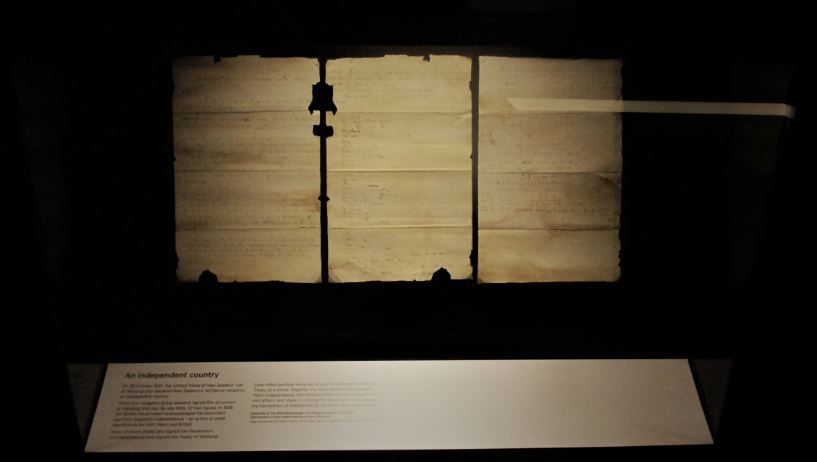
The Second Article of the 1835 He Whakaputanga states this hierarchy of authority, expressed as kingitanga, mana and Tino Rangatira are derived from the land and hapu, or extended whanau units. Therefore, the authority of the paramount chiefs is grounded in wenua, or land and whakapapa or genealogy. The chiefs declared that they were responsible for framing laws and only persons appointed by them would be authorized to set down laws consistent with the Confederation of New Zealand’s meetings, such that a governor could not make laws in conflict with the rangatira laws. In the English language version, Article Two render “all sovereign power and authority” to its hierarchical effects of mana to exert control, whereas in the Māori language version, mana’s source is derived from the land.
In Article Three, the paramount chiefs resolve to meet each year in the autumn at harvest time, under the auspices of Te Wakaminenga gatherings. The intent of these annual Runanga was to dispense justice, ensure peace and confront wrongdoing and lawlessness and facilitate fair trade in commerce. Article Three also called upon iwi and hapū in other areas to join Te Wakaminenga and quit inter-tribal warfare, which reinforced the northern rangatira of Ngāpuhi declaring that the ‘land [was] in a state of peace’.
Article Four of He Whakaputanga emphasized an extension of friendship and alliance with the British monarch and Britain, which had its roots with chiefs Hongi and Waikato visiting England and King George IV on November 13th 1820.The rangatira express appreciation for the King’s recognition of their shipping flag and then promise to extend friendship and care toward British settlers and traders. The Tribal Confederacy entreated to the King of England to be the Protector from all attempts upon their mana and sovereignty, while in the English version, mana and sovereignty was rendered as independence. In seeking the King to act as ‘matua’, rangatira were asking the King to be a parent to his own British family! While in the English version, this parent or protector role was rendered to frame the independent state as a candidate for protectorate status of British Empire. In his review for the Waitangi Tribunal, Carpenter believed, this rendering in English as “protectorate language was a prominent code for British control at the time.”xlv
In the drafting of this Declaration, the crucial differences in stating chiefly sovereignty belies Busby’s machinations to construct the edifice of national autonomy for later de-construction. In the English language version, chiefly sovereignty is construed as a confederacy comprising a small number of chiefs whom essentially are placed – unwittingly – in a position to over-reach their authority claiming an independent state, with a binding hierarchical power structure that sought protectorate status within the orbit of the British Empire. Whereas, in the Māori language version, He Whakaputanga o 1835, hapū autonomy remained intact since chiefly authority was anchored in the well-being and mana in their hapū regions.
The crucial differences between the drafts of the Māori language and English language versions of the 1840 Waitangi Treaty is not simply because Busby recruited the help of Eruera Pare Hongi, to draft the Māori language version of 1835 ‘Declaration of Independence’. In other words, in both the English and Māori language versions. The real reason is because the British game had been to erect the edifice of an independent sovereign state for its deconstruction at a later date.
To the British Crown, the 1835 ‘Declaration of Independence’ and its Māori language version known as He Whakaputanga o 1835 – formalized New Zealand as an independent state supposedly controlled by a confederacy of chiefs. It was recognized as such by the British Crown in 1836 and the British Parliament in 1838, but more accurately applied to the Northern parts of the North Island, as well as the Waikato and Hawke’s Bay. To the rangatira that signed He Whakaputanga o 1835 (or ‘A Declaration of New Zealand’s Māori Sovereignty’), the paramount sovereign power and authority that they asserted was derived from the sustaining and nurturing whenua or land. Because the United Tribes sought an alliance with the King William IV in return for protection from foreign invaders as well as trade, New Zealand, in effect, became a protectorate of Great Britain.
Crucially, the one account that survives is Busby’s report – which is rather telling since the Te Kara national flag of shipping had some ‘unhelpful’, independent accounts that contradicted Busby’s propaganda. This is despite Reverend Henry Williams, a prolific diarist, and CMS printer James Clendon being present.xlvi This sparseness in accounts was to be repeated when the Treaty Theatre Track advanced to its historic production at Waitangi in 1840, with Captain Hobson as director.
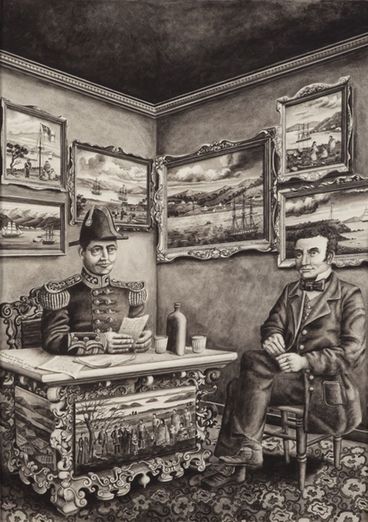
Like James Busby, Royal Navy Captain William Hobson was volte-faced in his dealings with Māori. Behind the friendly mask, was a scheming face and an ambitious egotistical mind. Captain Hobson first came to New Zealand in 1837, when he commanded the frigate, HMS Rattlesnake, to answer Busby’s dispatch to Sydney for help to quell fighting between two warring chiefs Pomare II and Titore. While briefly in New Zealand for between May and July, he visited other parts of the North Island.
The Royal Naval Captain had envisaged a ‘factories scheme’ for New Zealand that described a system of naval-protected trading posts owned by the British Crown, following a treaty. Captain Hobson’s 1837 plan envisaged the factory enclaves would be controlled by a British Governor, whom would have authority over Pākehā and Māori. In effect, this scheme meant the Secretary of State for War and the Colonies, Lord Normanby, and Secretary of State for Foreign Affairs, Lord Bro. Palmerston, well-knew that Captain Hobson’s Factory Scheme was based upon the factory trading system used by the British East India Company. That factory trading system had been copied from the Portuguese to gain a foothold in India in 1668, first on the Island of Bombay, its port and its harbour. Governor Bourke wrote to the Colonial Office conveying that Hobson’s proposal was premised on ‘Māori’ cheerfully conceding to the factory plan on terms of mutual interest. However, Hobson was evidently less confident than Busby that a treaty would work, because he felt Maori had no form of government and any hui with chiefs claiming to be the heads of the United Tribes would likely result in bloodshed.xlvii
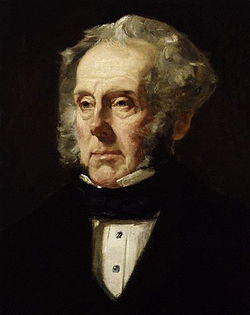
Thus, by sending no ordinary Royal Naval Captain to treat with the ‘Native Chiefs’ for their willing and conscious cession of sovereignty and informed consent to grant monopoly rights to extinguish native titles, Lords Normanby and Lord Bro. Palmerston made conscious decisions to sign-off on the trickery of gaining the appearance of paper sovereignty in 1840. That trickery was designed to eventually lead to structural entrapment – to justify a war of sovereignty. That structural entrapment would take the form of provoking Māori into reacting to incursions on their sovereignty, lands and customs, and would be the catalyst for the Northern War of 1845-46xlviii and the New Zealand Masonic Revolutionary War of 1860-1872.xlix
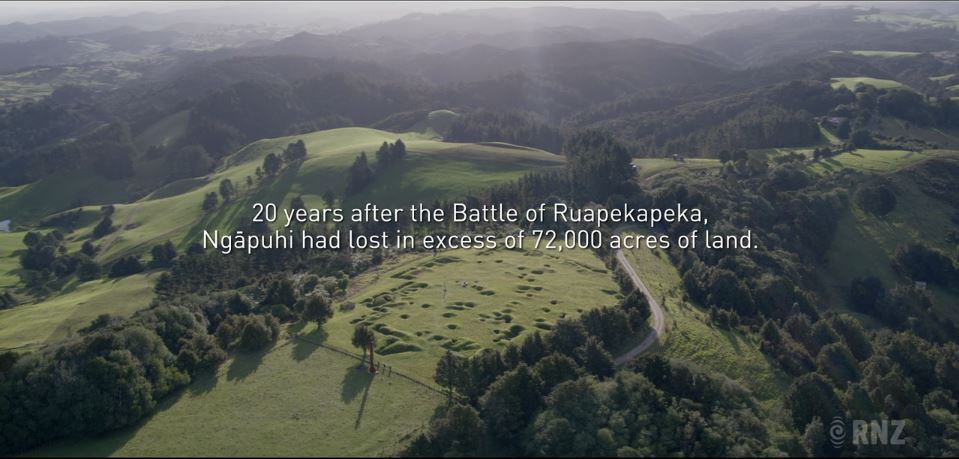
All the European Maritime Powers, and the United States, constructed treaties with indigenous peoples in the formation of their imperial colonies, as Matthew Wright found in Waitangi: A Living Treaty.l These treaties were drafted at the conclusion of ‘little wars’, to establish commerce, and territories. However, Wright states that the 1840 Waitangi Treaty was the only one that the British used to gain full sovereignty by paper with an indigenous people. Because this innovation contained the trick of language translation deceptions, I argue, it could only work once because if it were repeated the cover-story of a hastily-drafted treaty in a far-flung location amid pressure of immigrant-laden ships arriving, land speculating syndicates swindling ‘Māori’, and the perennial French bogeyman showing up – would have long ago collapsed.
Snapshot: The Treaty Theatre pivoted upon a fulcrum of deceptive translation differences in the 1840 Waitangi Treaty texts that hid the deceptive power crime to win native signatures and paper sovereignty.
In 1840, the 39 Māori signers of English language version of the Waitangi Treaty and the 473 Māori signers of Māori language version, Te Tiriti o Waitangi – intended that their paramount authority would remain intact. In the 217-word long sentence that comprises the Preamble of the English version, Queen Victoria was alleged to have extended “Her Royal favour” to invite the Aborignees to cede sovereign authority to her, signalled the formation of Civil Government and justified this move to avert evil consequences of unregulated emigration. This rambling Preamble stated Her Majesty was “anxious to protect … [the] just Rights and Property” of the “Natives Chiefs and Tribes of New Zealand”.
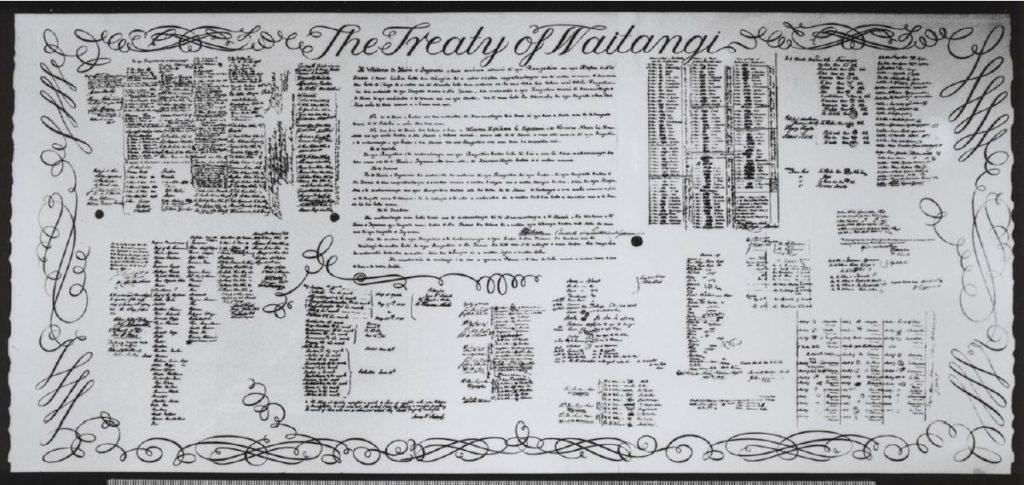
Crucially, in the te reo version of the Preamble, “just Rights and Property” are rendered as “o ratau rangatitiratanga, me to ratau wenua”, which meant “their chieftainship and their land”. The bearing of this difference is significant because “Civil Government” and “sovereign authority” were translated by Rev. Henry Williams into Māori as “kawanatanga”, or governance/governorship. Also, Rev. Henry Williams translated “functionary” as “kai wakarite” which meant an administrator, mediator, negotiator or adjudicator, meaning Hobson’s role would have been understood by Māori as an official appointed by the Queen to make decisions sitting with or below rangatira, not above.
In Article One of the Māori language Te Titiri o Waitangi o 1840, the chiefs conferred the right of governorship, meaning authority was granted to the Queen to appoint a Governor to rule over Pākehā only. Meanwhile, in the English text, the chiefs signed away, or ceded, complete sovereignty over their territories. Rev. Henry Williams achieved this sleight of hand by rendering Kawanatanga or governorship to mean sovereignty.li The effect was that Kawanatanga was essentially construed to mean that Māori ceded sovereignty over New Zealand forever to the Queen of England!lii
Māori chiefs thought they retained their chieftainship, or independent authority, with the crucial term – tino rangatiratanga – in Article Two of the Māori language version. Both mana and tino rangatiratanga were regarded as paramount, spiritually sanctioned, inalienable power, as Emily Blincoe noted in her law paper, “The Myth of Cession: Public Law Textbooks and The Treaty of Waitangi”, that endorsed the Waitangi Tribunal’s October 2014 report, The Declaration and the Treaty.liii
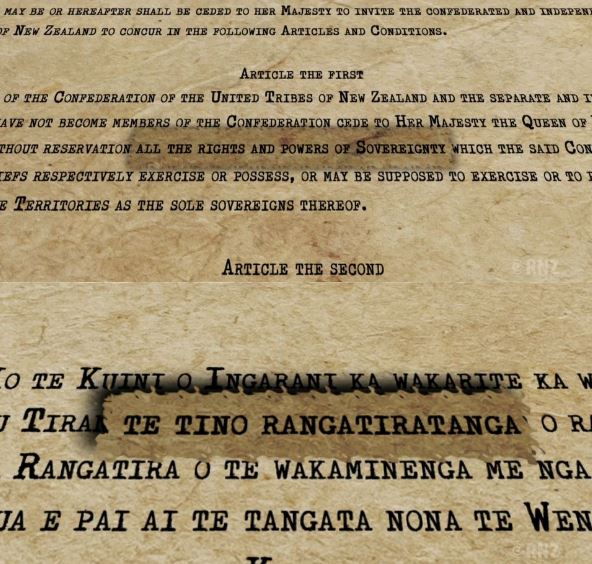
In Article Two of both texts, Queen Victoria upheld the chieftainship over lands, village estates and treasures, while in the Māori language version the British Monarch gained the right to appoint an agent to barter or trade in land. However, the Second Article’s English text conferred the Queen of England the right of pre-emption, which was said to mean granting the exclusive right to purchase Māori lands at agreed prices. This exclusionary blackballing right of pre-emption was poorly understood by rangatira. This Discovery element of Preemption/European title was a powerful mechanism since it not only created a monopoly for the British Masonic Empire over private British enterprises. By appearing to gain this right, the British Crown constructed the capacity to extinguish Indian or Native Title created on First Discovery, that had the potential to last forever if indigenous nations never consented to sell to the European Maritime Power claiming the exclusive Preemption/European title right. It also foreclosed rival European Maritime Powers from gaining this right. This Pre-emption right constructed a Crown land-acquisition monopoly which would mean Māori would bare the burden of being coerced to sell lands at low prices in a new colonial economy where the profits from reselling land at inflated prices would supply money for public works and emigration. In effect, Māori land owners were force to ‘pay’ a kind of capital gains tax, as Keith C. Hooper and Kate Kearins in their study, “Substance but not form: capital taxation and public finance in New Zealand, 1840-1859” published in the Journal of Accounting History.liv
In the Māori text of Article Three, the Queen contracted to look after the Māori people and was afforded a kaitiaki role of guardian, in recognition of the governorship role accorded to her. In the English text, ‘the Natives of New Zealand’ were given “all the rights and privileges of British subjects”, as consideration for their chiefs signing away sovereignty. According to this version of the Third Article, the Māori signers fully understood the Treaty.
Rev. Henry Williams was well aware of the imperfections in the translation, and framed it in a way that would be agreeable to rangatira, whereby they would be led to believe a protectorate was being constructed and Queen Victoria recognized their independent authority or tino rangatiratanga. Dame Anne Salmond pointed out that Rev. Williams had not made clear the sovereignty being ceded to Queen Victoria, as he had in the Māori version of the 1835 ‘Declaration of Independence’. Salmond stated:
“If Williams had used the terms ‘ko te kingitanga ko te mana’ (as he did in He Wakapūtanga) to translate ‘sovereignty’ in Ture 1 [Article One] of te Tiriti, and asked the rangatira to cede these powers to the British Crown, it is almost certain that they would have been angry and affronted, and that the negotiations would have failed. Instead, he couched the cession to Queen Victoria as a tuku or release of ‘kāwanatanga”.lv
When vital consideration of the re-examined accounts of the circumstances that preceded the signings, the discussions rangatira had with Lieutenant-Governor Hobson, his agents and the missionaries, and the sly symbolic cession rituals of empire – are all laid bare – it is evident that rangatira were agreeing to the appointment of a governor to rule over unruly Pākehā, not Māori.lvi
Those Māori that signed were convinced by the sales-pitch of Hobson and Associates that they were signing a treaty with a great power to not only discipline troublesome Pākehā, but also to address land-swindling and protect Māori from foreign invaders in exchange for trade, limited immigration and co-development.
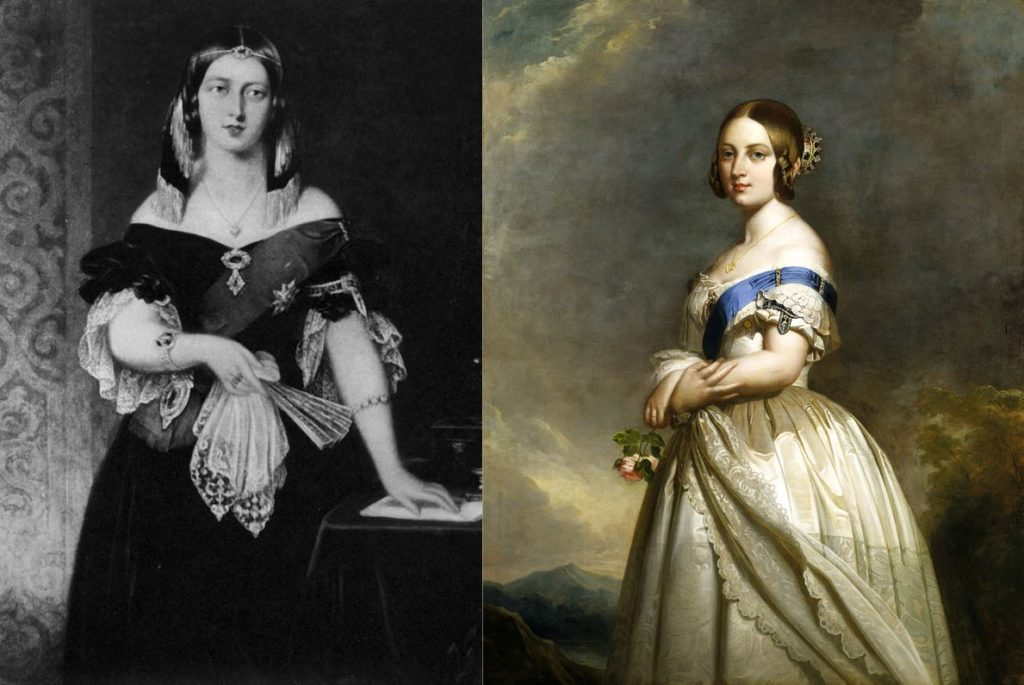
Furthermore, crucial assurances of Royal Navy Captain Hobson, his British Crown agents and the Protestant missionaries were given to rangatira, explicitly stating: (1) Queen Victoria would not dispossess Māori of their lands they did not willingly sell; (2) Māori would not become enslaved; and (3) rangatira would still retain their chiefly authority – as Dame Claudia Orange found in her Goodman Fielder Wattie prize-winning, imaginatively titled, 1987 book, The Treaty of Waitangi.lvii
Where Rev. Henry Williams’ hand clearly asserted Māori sovereign power and authority in the 1835 Declaration of Independence, that same hand wrote the 1840 Treaty of Waitangi, with more ‘poisoned ink’. Moreover, the freshly retired official British Resident James Busby drafted the English language version of the 1840 Treaty. Busby had worked with his friend Rev. Henry Williams on the 1835 ‘Declaration of Independence’, wherein they performed the same roles. Like Rev. Williams, Busy too had a past, one best described as a covert role was that of an Agent Provocateur to affect submission, exert authority and spread fear.
Prior to its deployment in the 1840 Waitangu Treaty, the pre—emption term as an exclusive land purchasing monopoly had only appeared in United States court cases in regard to the English colonies. In his 2011 book, Lords of the Land: Indigenous Property Rights and the Jurisprudence of Empire, Mark Hickford stated that New South Wales Governor George Gipps (1837-46) appeared to the be the “proximate source” of the pre-emption clause. Hickford said Gipps held an extensive collection of legal and historical tomes that he drew upon to exercise “the entitlement of imperial administrations to manage anglophone settlers and territories in alien locations”.lviii In law, pre-emption has another meaning, whereby a state acts pre-emptively in times of war, for instance, and takes land or resources before law is established. Conspicuously, the 1840 Treaty contained no provision for leasing Māori land, nor for Pākehā being conferred limited rights to use land, sea and other taonga or treasures that rangatira maintained control over.
Like all criminal plots, not everything went according to plan. Three ‘clanker moments’ that occurred during the 1840 Treaty hui at Waitangi required subterfuge by way of improvised theatre to avert the truth surfacing.
Discovery Doctrine & Treaty Clique’s Clanker Moments
Snapshot: A hidden Discovery Doctrine was deployed to gain paper sovereignty over New Zealand from Māori as part of a long game that would inevitably lead to war.
As the ‘stage director’ of what was really a ‘Waitangi Treaty Theatre Company’, Captain Hobson, leaned on the Protestant missionaries to help him persuade the rangatira about the benefits of a treaty with the British. Captain Hobson’s mission to persuade, or charm offensive, which occurred with unseemly haste, and along with the cast and props including the treaty sheets, quills and ink, made for New Zealand’s second theatre company – the first being Captain Cook’s voyages.
Scholar Professor Robert J. Miller, who published his findings in a book titled, Native America, Discovered and Conquered, identified ten elements of the Discovery Doctrine. The ten Doctrine of Discovery elements are: (1) First Discovery; (2) Actual Occupancy and Current Possession; (3) Preemption/European Title; (4) Indian Title; (5) Tribal Limited Sovereign and Commercial Rights; (6) Contiguity; (7) Terra nullius; (8) Christianity (9) Civilization; and (10) Conquest. Because the elements of this Discovery Doctrine are present in the circumstances, texts and intent of the 1840 Waitangi Treaty, as well as the earlier 1835 ‘Declaration of Independence’ – and therefore the Declaration’s hidden bearing of steering Māori toward an eventual loss of substantive sovereignty – these Discovery elements are identified as they surface.
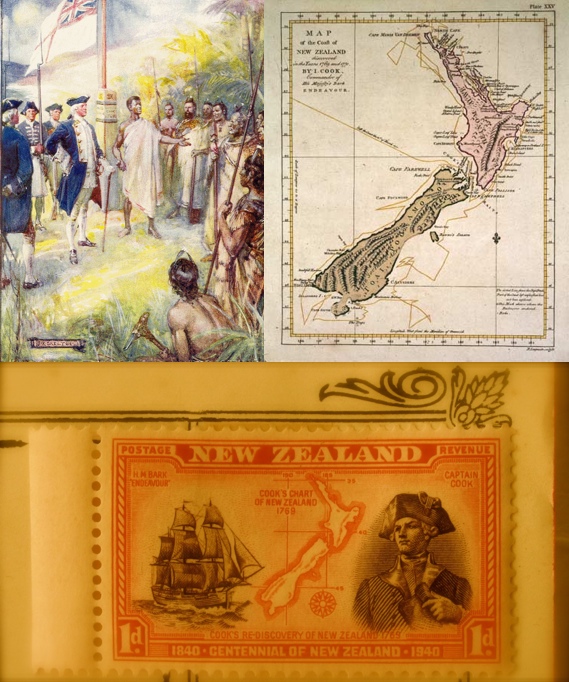
The 1840 Waitangi Treaty was a Discovery Doctrine event brazenly designed as a deceptive power crime to win native signatures and paper sovereignty through the construction of a copy of reality. Once this copy of reality was embarked upon, conspiring players performed a theatre of contrived ignorance, including those who did not necessarily agree with the deception at Waitangi.
“Ostriches … are not merely careless birds.”
To this eventual end, the Treaty Cliqué at the scene of the 1840 Waitangi parchment crime included: Royal Navy Captain William Hobson, who convened a conclave of Protestant Missionaries aboard the ship, Herald; the primary drafter of the English text, British Resident James Busby; and the primary translator of the text into Māori, Church of England Reverend Henry Williams. This Cliqué also included: Captain Hobson’s Chief Clerk, James Freeman; Surveyor-General Felton Mathew; the CMS Missionaries, Richard Taylor, William Colenso, Charles Baker and George Clarke, and French Catholic Bishop, Jean Baptiste Pompallier. Remotely, the Treaty Cliqué included: Secretary of State for War and the Colonies, Lord Normanby; Governor of New South Wales George Gipps, and Secretary of State for Foreign Affairs, Lord Bro. Palmerston, the world’s High Priest of British Freemasonry.
Clanker Moments at Waitangi
The three ‘clanker moments’ that occurred during the 1840 Treaty hui at Waitangi required subterfuge by way of improvised theatre to avoid the entire fiction of the travelling production careening into a ravine of revelations. The risk of their ‘unveiling’ hinted at the Discovery Doctrine elements.
The first clanker moment came when Chief Te Kemara of Ngāti Rāhiri hapū – whom were hosting the hui since the meeting was technically and ironically on their land, but exclusively claimed by Busby – complained that the Anglican missionary Williams family had swindled him out of his land. The second clanker occurred when French Catholic Mission, Bishop Jean Baptiste Pompallier, interjected to ask Royal Navy Captain William Hobson – who was appointed British Consul to gain paper sovereignty – if there would be tolerance for diverse religious teachings under the treaty. A clanker moment of a third kind happened as Chief Hōne Heke Pōkai got up to sign, when Church Missionary Society (CMS) printer William Colenso asked Captain Hobson if the “Native chiefs” understood the treaty. Each of these clankers could have derailed what was, in effect, a track-laying vehicle for the British Masonic Empire to forge a colony out of what had been construed in 1835 as an independent Māori state comprised of numerous hapū and iwi.
That track-laying vehicle was the Discovery Doctrine.
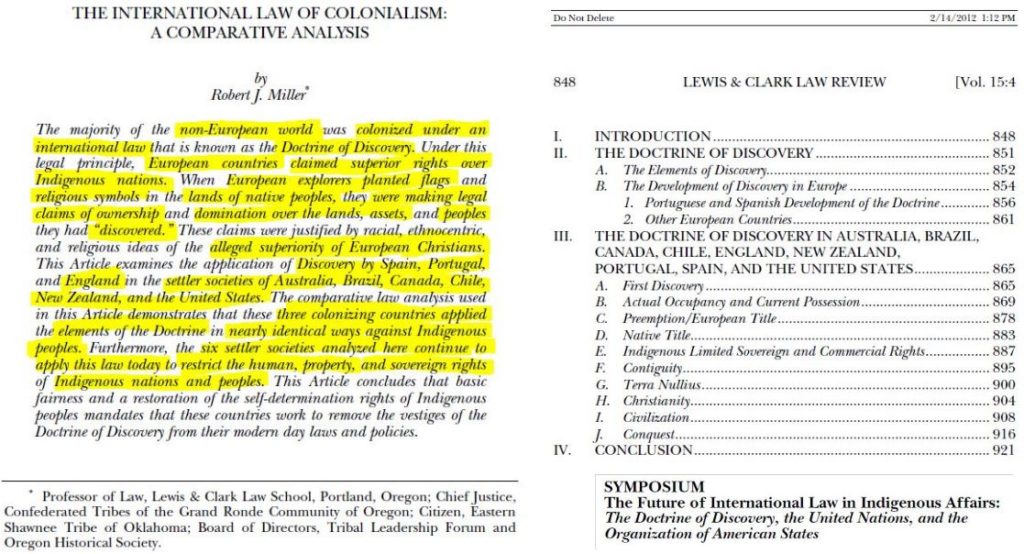
If there had been defections by participants within the Treaty Cliqué during these clanker moments, the elements of the Discovery Doctrine would been exposed and its use as a track-laying vehicle ruined, without the chiefs needing to know about the doctrine itself. If a full-blown mutiny at Waitangi had revealed essential facts of context, it is likely that a walk out by the chiefs would have ensued, word would have spread. The likelihood that Captain Hobson’s, James Busby’s and Reverend Henry Williams’s heads being skewered on sticks by sunset might have prompted Treaty Cliqué’s surveyor Matthew Fenton to switch allegiances, and offer his artistic skills skilled to sketch and paint their demise for posterity to save his own skin.
The contextual facts of these clanker moments remained unspoken at Waitangi and therefore they remained at-large for historians to piece together later. Until now, however, the three clanker moments have not been identified as such, and therefore the task to summarize them and their significance has fallen upon The Snoopman nearly 180 years later.
When Chief Te Kemara supplied the first clanker aimed primarily at Rev. Henry Williams for swindling him of land in 1834, at a time when Māori had little understanding of private land tenure, the CMS Anglican missionary made inaudible and incomplete translations of Chief Te Kemara complaints and similarly those of Ngāi Tawake rangatira Rewa. Rev. Williams, who possessed 11,000 acres, defensively insinuated he was generous by paying a sum equal to the value of twice the acreage, which was still a pittance – since it would be lost forever. The Anglican missionary justified his large land holding as a means to provide for his children, since the Church Missionary Society had done little to provide cash. Slyly, Rev. Henry Williams, as the most senior Church Missionary Society clergyman, was masking his role in implementing an element of the Discovery Doctrine, Actual occupancy and current possession. A European Title could only be produced from First Discovery if the European country occupied and possessed their newly found lands. Fort building and settlements had to occur within a reasonable period, to complete the annexed title. Rev. Williams also complained he and the other missionaries had done so much for ‘the natives’ to lay the groundwork of civilization that his land holdings were justified reward.
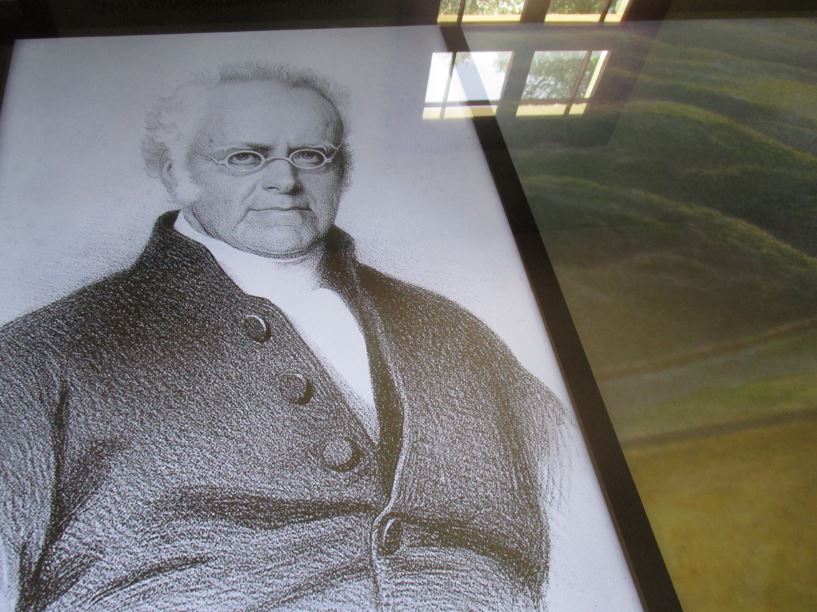
Here, Rev. Williams’s attitude, in effect, belied an activation of the Discovery Doctrine element of Christianity and its conception of Civilization. As Discovery Doctrine scholar Professor Robert Miller states, “[u]nder Discovery, non-Christian peoples were not deemed to have the same rights to land, sovereignty, and self-determination as Christians.” Discovery’s Civilization element deemed that settlements were supposed to be surrounded by pastoral farming and crops. This Civilization element, along with the others, was highly subjective, and therefore meant the Crown would not accommodate or treat Māori land use and tenure on a par with European legal systems. In this way, the first clanker hit the Substantive Sovereignty Cog, which could only spin at full torque when the Māori communal economy was destroyed by land confiscations in war and peace, by swindle in purchases and promises, and by stealth in legislation, cases and myriad legal mechanisms cooked up by Pākehā ‘kitchen cabinets’.
The interjection of the French Catholic Missionary, Bishop Jean Baptiste Pompallier to ask if all religious creeds would have a place, provided a glimpse of the dark history between the British, French, American and Vatican Empires represented at Waitangi in February 1840. With this second clanker, Bishop Pompallier could have derailed the criminal proceedings to annex New Zealand by stealth, had he been open with the Māori about the rivalrous multi-century antagonisms between Sionist Rosicrucian Freemasonry, French Templar Freemasonry and the Vatican’s militant brotherhood of Jesuits. Māori in 1840 knew nothing of the rivalry between English Sionist Rosicrucian Freemasonry and French Jacobite Templar Freemasonry that had underpinned the epic warring between Britain and France. Yet, they were supposed to view British as a force for the light, and French as a force of darkness. As such, Māori in 1840 did not know that there were two British Empires, one Christian comprised of missionaries exerting ‘soft power’. The other, a hidden British Masonic Empire hell-bent on world domination that competed with Templar Freemasonry, whom had skillfully wrested control of America from the British Masonic Empire in the American Revolution and consolidated that win in the War of 1812.
Because Bishop Pompallier had a scheme of his own, he did not explain to Māori that the British and French had been warring for centuries. Pompallier wanted to beat the British and claim the South Island with a treaty for Catholic France, which would have meant the North Island would have become a British Masonic jurisdiction, while the South Island would have become a territory of the Vatican Empire. French Navy Captain Lavaud in the command of L’Aube, reported that Bishop Pompallier had said to him he could “press ahead and annex the South Island” and evidently added that “the English had done a great conjuring trick there”. lix
Yet, Pompallier’s claimed that prior to February 5th treaty hui, he had “enlightened the chiefs about what was involved for them and then left them to make their own decision, remaining politically neutral myself… Besides, I was quite sure that the request for signatures was only a pretext, the annexation was decided on …”. In other words, he had kept what he knew to be true from rangatira.
“Ostriches … are not merely careless birds.”
In response to Pompallier’s request, Hobson assured the Bishop that all creeds would be respected. Pompallier wanted something more than just spoken words. This was telling given that the chiefs relied more on spoken persuasion than on what was written down, and were unaware of the ruse in play regarding language translation differences – which Pompallier was conscious of.
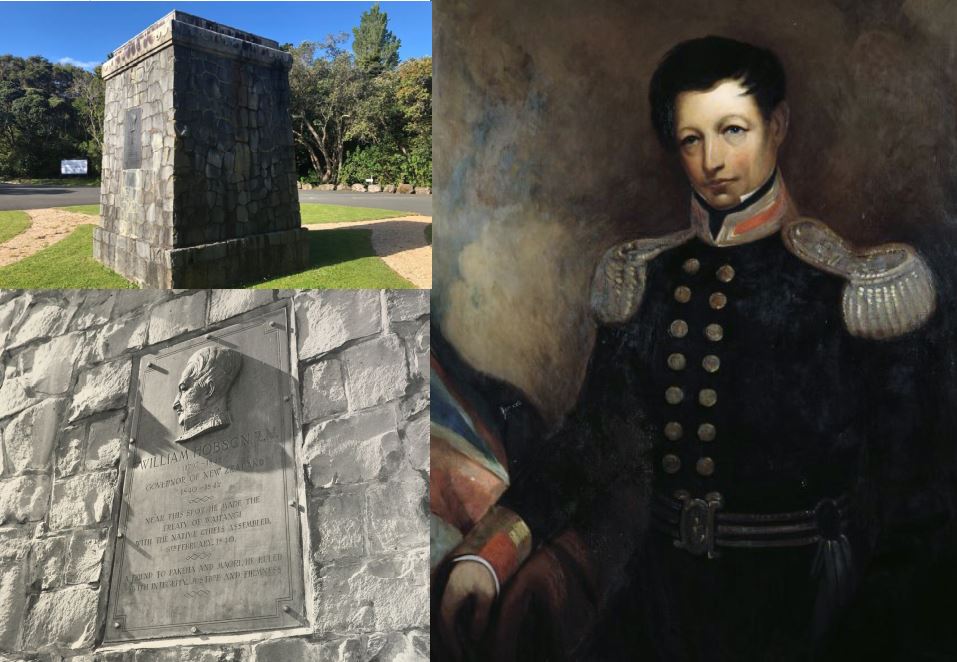
Captain Hobson was astute and could see that this fourth article of the Treaty was needed to gain chief support of those affiliated with Pompallier. Ironically, the fourth article was, on paper at least, a counter to bigotry. Yet, it would become clear by the Northern War of 1845-46 and the New Zealand Masonic Revolutionary War of 1860-72, that the Crown was intolerant of Māori independence exerted through retention of lands.
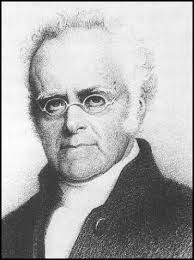
Church Missionary Society (CMS) printer William Colenso could also have derailed the epic rort in play when he cautioned the missionaries that they had a duty to explain the treaty “in all its bearings to the Natives” so that the Treaty is “their own very act and deed” (rather than a dark work of criminal fiction). Colenso even foresaw the consequences when he said that Māori would have every right to confront the missionaries in the future for failing to make clear what the Treaty contained. Conspicuously, Captain Hobson made no further effort to explain to Māori assembled that the English version stated Māori would cede forever sovereignty over New Zealand to the British Monarch. Moreover, Rev. Henry Williams ‘failed’ – even after Colenso’s caution – to point out the deliberate differences between the two language versions of the Treaty to the chiefs assembled.
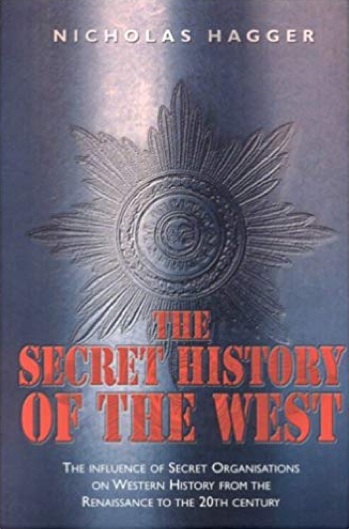
As Anne Salmond noted in Tears of Rangi, Henry Williams emerged as a “pivotal figure” in the Waitangi Tribunal hearings into the 1835 Declaration and the 1840 Treaty events. The battle-hardened naval lieutenant-turned missionary had fought in the Napoleonic Wars, which included the so-called ‘War of 1812’.lx These wars were actually part of British Freemasonry’s war against French Templar Freemasonry – as these conflicts become clear from reading English historian Nicholas Hagger’s epic study, The Secret History of the West, and Anthony Chaitkin’s, Treason in America.
The identification and location of these clanker moments in this deep historical context are pivotal to comprehending the machinations that underpinned the construction of the Treaty Theatre Track. The Treaty Theatre could only work if all hands, tongues and ‘sincere’ face-masks acted in unison with unseemly speed through the phases of scripting, ritualistic theatrical persuasion performances and the poste haste Waitangi Signing Tour Rituals – lest the imperial intrigue become obvious. Betwixt the spiraling momentum of deception in the unfolding events – that were embedded with weaponized speed – the Treaty Cliqué’s scheme almost went awry when three clankers moments emerged during the discussions at Waitangi in 1840. The narrative elements in the Crown’s bedtime fairy tale creation myth of how and why the New Zealand State became a British Colony in 1840 becomes sharper when by adding a ‘Masonic lens’ to view these clanker moments. A ‘Masonic lens’ clarifies the events, principle players, and the British Deep State’s machinations to forge a British Masonic jursidiction, in part to forestall their perennial rival, French Templar Freemasonry, whom as a secret Brotherhood succeeded in winning the American Revolutionary War (1775-1783) to establish the United States as a Masonic Templar State.
With this sharpened view, works such as Mike King’s Waitangi Treaty documentary series – Lost in Translation – could be reworked, especially the first episode which was evidently dedicated to Mike King’s ego. The film-tape and air-time expended on the comedian’s boring awakening story after recovering from a heart attack, can now be used to explore the clanker moments as being consistent with the uneasiness, defections and staged challenges to the in-built fraud that the Treaty Cliqué all knew to be true.
Indeed, Henry William’s sounded out chiefs prior to February about the use of the word mana – realized they’d never agree to its use in a mana-surrendering context and choose instead to use kawanatanga to convey the idea that the British were asking Māori to agree to a governor to rule over Pākekā. Therefore, if Mike King’s reversioned first episode made it clear that both versions were read out at Waitangi and therefore those who were fluent in English and Māori could tell the fraud, then it becomes clear that James Busby, James Clendon, Protestant CMS missionaries Henry Williams and William Colenso, and Catholic Bishop Jean Baptiste Pompallier among other, were in on the ruse directed by Captain William Hobson.
Hobson’s Theatre extended to shaking the hands of each signing chief, saying “He iwi tahi tatou” or “We are now one people”. This ‘One People’ Snake Oil salesmanship was assisted by Colenso’s attentive distribution of the presents, two blankets and a quantity of tobacco to each rangatira. The flags at Waitangi – on land stolen by James Busby – were part of the Discovery Ritual pomp.
After the Treaty was signed at Waitangi, on February 19 1840 James Busby advanced what he claimed was a ‘deed of cession’ for the land he confiscated off Chief Rete at Puketona. In a letter to Captain Hobson, Busby claimed the confiscated land “was offered by the chiefs to me as a compensation, and only confiscated in His late Majesty’s name to give more solemnity to the transaction”. Busby and other settlers had been foiled when his attempt to insert a clause into his English language Treaty draft, providing for British settlers to have representative rights was erased by Captain Hobson. On 19 March 1840, Hobson sent Busby’s documents to Sydney, where Governor Gipps ruled that Busby had no valid claim to the land at Puketona, and in 1843 instructions were issued to the Surveyor General to surveyed the land for Crown retention, and, in effect, re-asserting a punishment for incident that took places approximately six years prior to the 1840 Waitangi Treaty signings – as Vincent O’Malley noted in Beyond the Imperial Frontier.lxi
However, O’Malley appeared to be unaware that Rete was exercising a muru, and he therefore missed the significance of this particular machination. Busby was exacting the Discovery Doctrine element of Settlement in an attempt to solidify his land claims, which in total amounted to 143,000 acres at the time of the Treaty signing at Waitangi.lxii
Key Finding: The Treaty Theatre pivoted upon a fulcrum of deceptive translation differences in the 1840 Waitangi Treaty texts that worked to hide the omissions of imperial context, intent and history.
The ‘Colonial Law Track’
The ‘Colonial Law Track’ moves were started by King George III who signed off on Captain James Cook’s instructions, for the Endeavour voyage he personally contributed £4000, and which resulted in Cook claiming possession of New Zealand for His Majesty at two places, in 1769 and 1770.
Freemason Captain Bro. James Cook secret instructions from the Admiralty did not specify taking possession or to seek the “Consent of the Natives”, despite what many lazy historians claim. That particular instruction was for the Great Southern Continent, Terra Australis, and for other islands he found inhabited that had not been previously discovered by any other European. But, since Captain Bro. Cook did report he had claimed possession at two places in New Zealand, its fascinating to note that his written secret instructions from the Admiralty did not state exactly how he might achieve that consent without his head becoming skewered on a stick.
It would appear there was another set of instructions, since Secretary of State to the Admiralty Lord Shelburne (William Petty) carried King George III’s Royal instructions to the Admiralty, as David Wood wrote in his 1947 book, Cook The Explorer. To convey an idea of the calculus of the British Masonic Empire during the reign of King George III (1738-1820), Lord Shelburne was the overlord of the British Secret Intelligence Service, which was an alliance between English, Scottish and Swiss ‘noble’ families, as Anthony Chaitkin found while researchinghis book, Treason in America, that explored their subversion of the United States of America from the American Revolution to World War II. Lord Shelburne would later set in motion an orchestrated subversion of rival states, such as France, Spain and America following the loss of the 13 colonies in 1783 at the end of the American Revolutionary War (1776-1783), which established the United States of America as a Templar Masonic State.
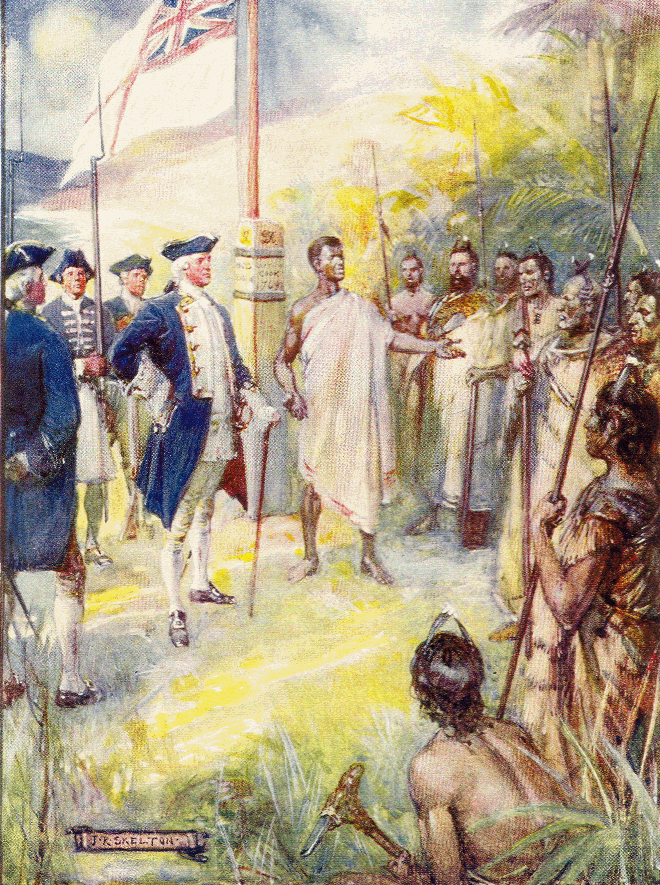
Where the British Admiralty were guarded about the means to gain consent of inhabitants in ‘discovered’ lands, the Dutch were quite open about how to construct voluntary assent or submission through means of ‘friendly persuasion’.
The Dutch United East India Company’s instructed Captain Tasman to plant symbols of “actual occupation” which were either a memorial stone or the Netherland’s prince flag. These objects, as graphic symbols, were meant to be erected or hoisted as possession rituals to lay claim to any lands that the Dutch explorer discovered, touched and set foot on.
Crucially, to fulfill the taking of possession of ‘discovered’ lands, Tasman was also supposed to gain the voluntary assent or submission of the people of any inhabited lands through “friendly persuasion”, or “planting a small tree in a little earth”, or “by erecting some stone with the people”, or by way of hoisting “the prince flag to commemorate their consent”.
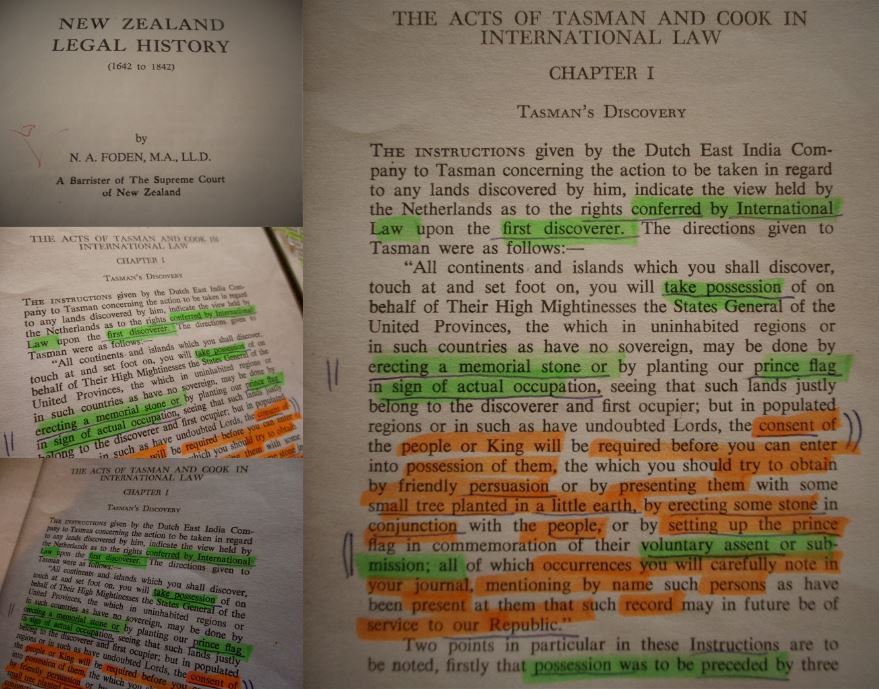
Captain Bro. Cook’s vision that New Zealand would made an execellent base for the British Empire in the South Pacific was advanced when the archipelago was included within the jurisdiction of the colony of New South Wales in 1788 until 1817 or 1823, depending on whose view you take. In his paper, “Was New Zealand part of New South Wales 1788-1817?” Professor Lyndall Ryan states that 1817 the British government ruled that New Zealand was not part of NSW. In 1823, New Zealand was taken out of the jurisdiction of the colony of New South Wales, supposedly due a mistake in not being mentioned as part of the territory of New South Wales of Van Diemens Land. However, in his 1926 book, New Zealand: Its Political Connection with Great Britain, J. I. Hetherington believed the omission was deliberate.
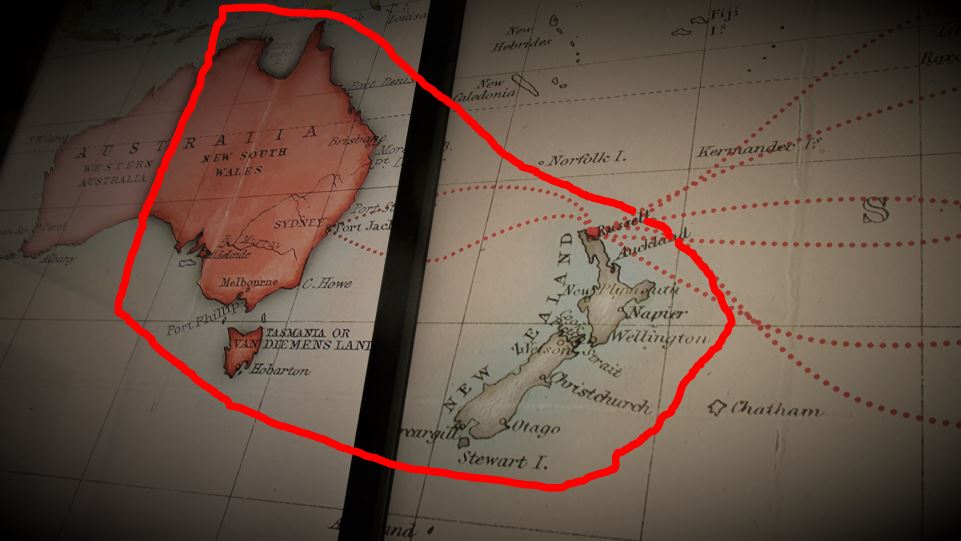
In 1825, the first New Zealand Company was established, to supply organized settlement of Europeans in New Zealand, and although the company’s ships, Rosanna and Lambton, voyaged around the coasts in 1826, the project failed. Some of the first New Zealand Company players would re-emerge in the second New Zealand Company, that sent ships in May 1839 to swindle large tracts of land, precipitating the British Crown to activate the final stage of annexation to claim sovereignty over New Zealand with a series of legal moves that The Snoopman has identified as the ‘Colonial Law Track’.
The final stage of the ‘Colonial Law Track’ were started and completed by the inky, feathery quill of Queen Victoria, whomperfected the incomplete title stealthily gained by Freemason Captain Bro. James Cook – as The Snoopman shows in his heretical investigation,“Royal Landlord Possession Rituals”.lxiii To that devious end, on June 15th 1839, Queen Victoria exercised her Royal Prerogative Powers to sign a decree known as the Letters Patent of Boundary Extension that enlarged the boundary of New South Wales, which had the effect of enveloping all of the islands of New Zealand within the jurisdiction overseen by Governor George Gipps. This parallel Colonial Law Track to the Treaty Theatre Track was essentially completed on 16th November 1840, when Queen Victoria signed the Royal Charter for Severance (or Charter of 1840), establishing New Zealand as a separate colony.
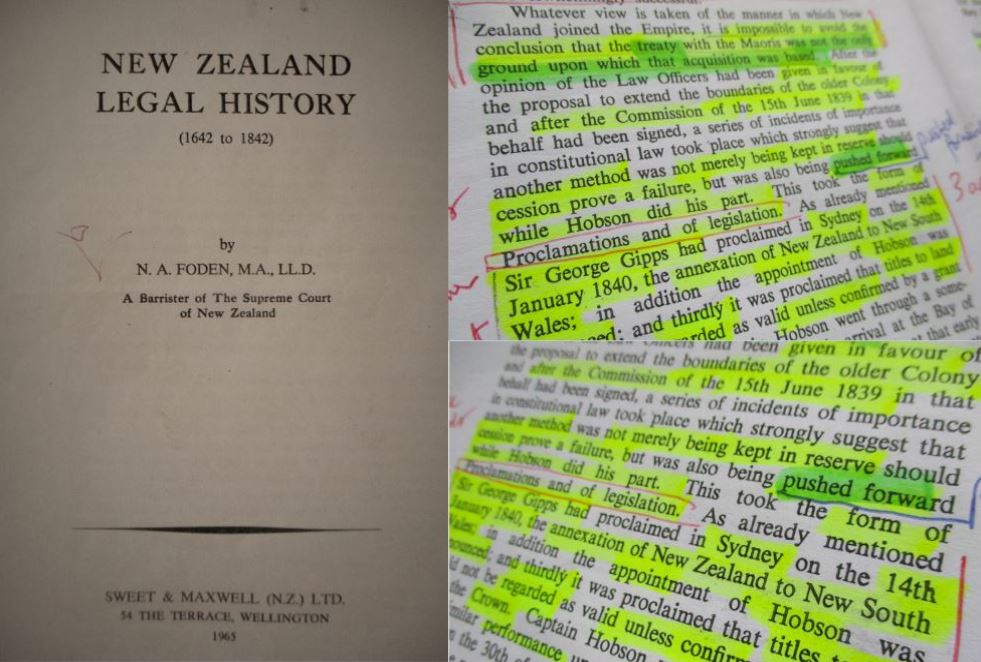
The key pieces of parallel Colonial Law Track laid to the Treaty Theatre Track to gain British paper sovereignty were: (1) a Letters Patent of Boundary Extensions signed by Queen Victoria, dated June 15th 1839, which expanded the jurisdictional boundary of New South Wales to include all of New Zealand; (2) a Letters Patent of Amended Commission to Governor George Gipps making him Governor of New Zealand, a new dependent colony of New South Wales, signed by Her Majesty’s Command bearing Lord Normanby’s name on July 30th 1839; (3) Governor George Gipp’s Proclamation of January 5th 1840 establishing N.Z. Customs; (4) Gipp’s three Proclamations of January 14th 1840 notifying the extension of the boundaries of New South Wales to include New Zealand, Captain Hobson’s Commission as Lieutenant-Governor and a notice that land Sales after January 5 1840 would not be valid and land sales before that date would be subject to official scrutiny; (5) Captain Hobson’s Proclamation of January 30th 1840 declaring himself as Lieutenant-Governor in an Anglican Church in Kororāreka before 300 settlers and 100 Māori; (6) Lieutenant-Governor Hobson’s Proclamation of May 21 1840 claiming sovereignty over the North Island on the basis of cession by Treaty and over the South Island on the grounds of Cook’s Discovery; (7) the New South Wales Continuance Act (or the “New Zealand Act of 1840”) with a separation empowering clause to sever New Zealand from its status as a dependency of New South Wales without expressly naming New Zealand, was passed in the NSW Legislature in May 1840 and the New South Wales Continuance Act was passed in Britain on 7 August 1840, with the separation empowering clause to erect a separate Colony of out of those islands considered as Dependencies of New South Wales; (8) Ratification of Hobson’s sovereignty Proclamation in the London Gazette on October 2 1840, after they were received in London on September 28 1840; (9) the Royal Charter for Severance (or Charter of 1840), signed by Queen Victoria and dated 16th November 1840 establishing New Zealand as separate colony; (10) the Governor’s Commission of 24 November 1840; (11) the Royal Instructions of December 5th 1840; and (12) Hobson’s oath as Governor and Commander-in-Chief on May 3rd 1841, which was notification that New Zealand was no longer a dependency of New South Wales. These moves to gain sovereignty over New Zealand made prior to, during and after the signings of the 1840 Waitangi Treaty were the real means by which the British Crown laid claim to paper sovereignty, and perfected the incomplete First Discovery title claimed by Freemason Captain Bro. Cook for the British Masonic Empire.
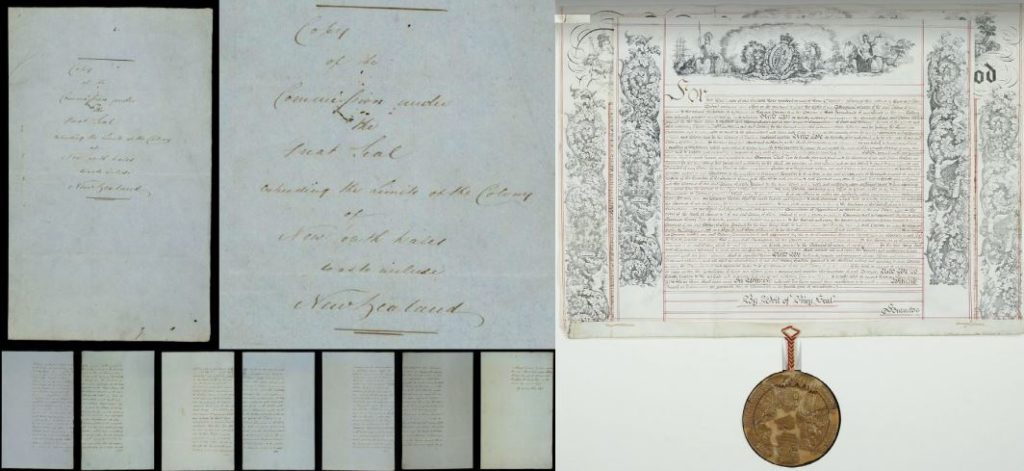
Government historian Richard S. Hill stated in his history of policing in New Zealand, that ‘cession by treaty’ was a pretence to neutralize anticipated Māori opposition, stonewall representative civil government for settlers, and to deconstruct the façade of an ‘independent state’, designed by the British. Hill found New Zealand joined the British Empire on the basis of settlement by the continuous occupation of 2000 Britons, when it was annexed by the Letters Patent of Boundary Extension on June 15th 1839 – while researching Policing the Colonial Frontier: The Theory and Practice of Coercive Social and Racial Control in New Zealand, 1767-1867, which was published in 1986 for the Department of Internal Affairs. Settlement, once formalized by a European Power, became an unchallengeable title.lxiv
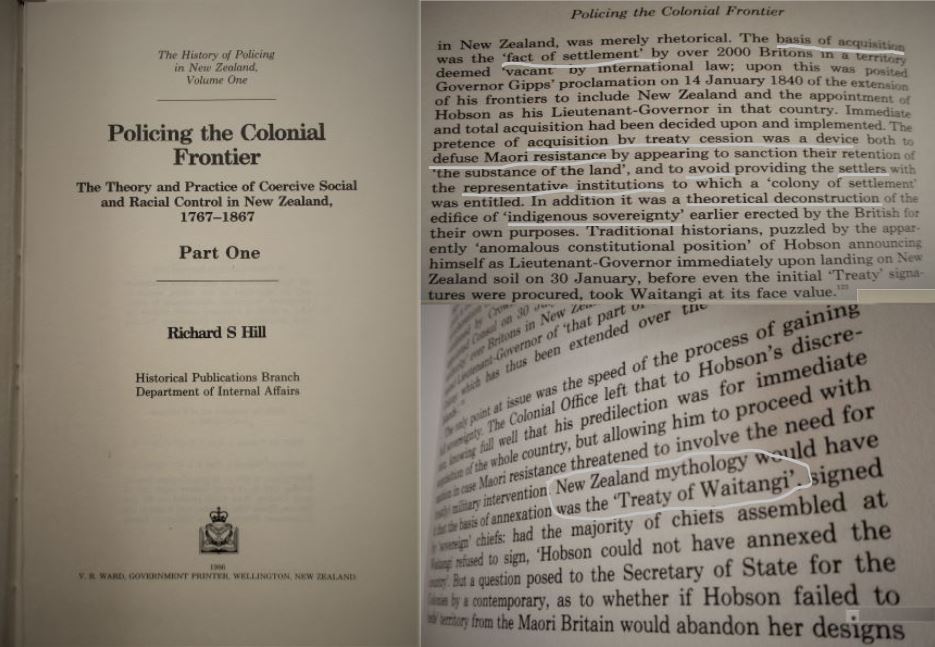
This finding concurs with Norman Arthur Foden’s thesis in his 1938 work, The Constitutional Development of New Zealand in the First Decade (1839-1849).lxv Foden also found at the time of the British takeover of New Zealand, there were three classes of colonies designated according to their mode of origin: by settlement (or occupation), by conquest and by cession.lxvi
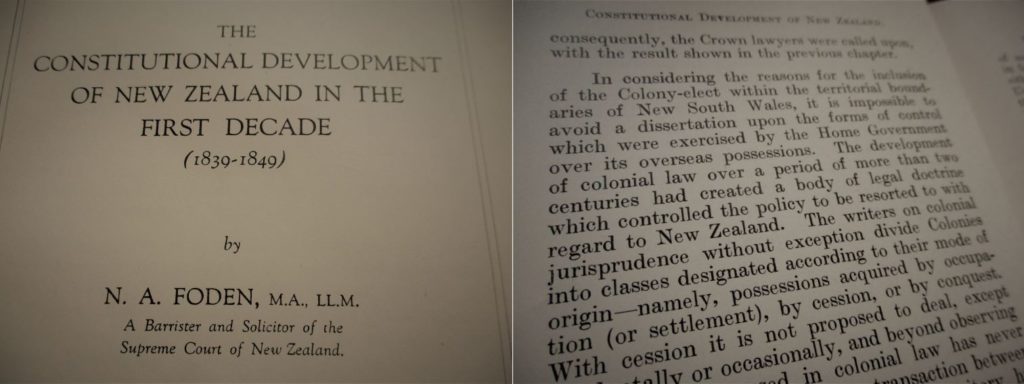
However, cession of territory by indigenous peoples to a European power was considered invalid in colonial and international law because they were considered coercive. Despite producing another ground-breaking book, New Zealand Legal History (1642-1842) published in 1965, in which Foden again explored the parallel track ‘pushed forward’ to claim full paper sovereignty over New Zealand, the former barrister and solicitor of the Supreme Court was unaware of the language differences in the 1840 Waitangi Treaty.lxvii
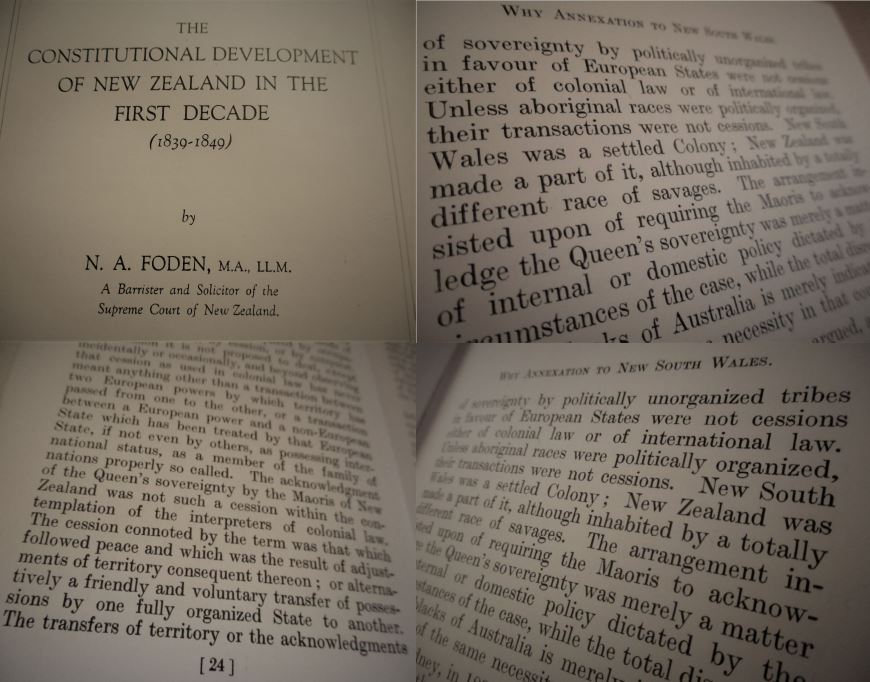
Writing in 1958, Parliamentary Historian Dr. A. H. McLintock essentially concurred with Foden’s work, when he stated that the Treaty was invalid as an instrument of cession because was not possible in 1840 nor in 1950s for “a convenant between the Crown and a number of savage tribes to be construed into an agreement between sovereign states in accordance with the usages of international law.” McLintock concluded that “New Zealand therefore lies within the category of colonies acquired by occupation,” since the grounds for acquisition by cession were mixed. As with Foden, McLintock was not only writing at a time before scholarship had moved past the Colonial-era casting of indigenous peoples as ‘savages’ and ‘natives’. Both scholars were writing before discourses on the language differences emerged in the public sphere, and were finally given validity by the Ministry of Justice’s Waitangi Tribunal in 2014 finding that no Treaty Chiefs ceded sovereignty.
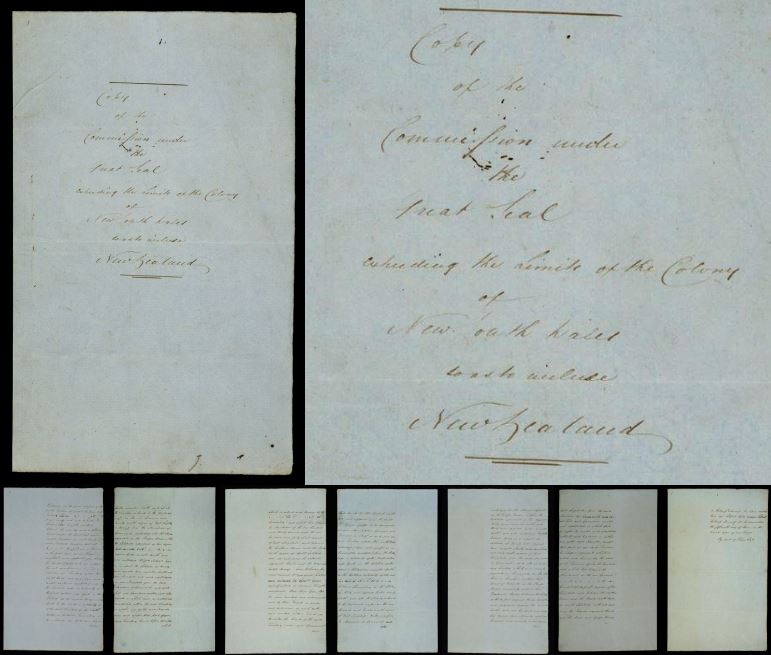
this Letters Patent of Boundary Extension of 15 June 1839 extended the limits of the colony of New South Wales so as to include New Zealand. Archives New Zealand Archway Item ID:R21434429.
When Chief Nōpera Pana-kareao signed the Waitangi sheet at Kaitāia on 28 April 1840, with his wife, Ereōnora, he said:
“The shadow of the land goes to Queen Victoria, but the substance remains to us; we have now a helmsman; before everyone wished to take the helm. One said, ‘Let me steer.’, another, ‘Let me steer’, and we never went straight.”
By ‘shadow’ Nopera meant the British Monarch was extending a protective blanket, while sovereingty over the soil was held by rangatira.
At the end of his chapter, “The Long Roll of Parchment” in his 1965 book New Zealand Legal History 1642 to 1842, Norman Arthur Foden noted the unease felt by the British Parliamentary Under-Secretary of State for the Colonies, Mr R. Vernon Smith, upon reading of Chief Nopera’s now famous line. Vernon Smith had read a dispatch from James Stephen in which the Secretary of State reported Nopera’s words. Adding in a minute to Vernon Smith, Secretary of State James Stephen wrote:
“This is merely a continuation of the reports relating to the cession of Sovereignty. I commend the accompanying speech for your perusal. There is, I think, great merit in the New Zealand style of public speaking.”
In a dispatch to Lord John Russell, the Secretary of State for War and the Colonies, Vernon Smith replied:
“Yes, but I fear they will discover that the subjects of Queen Victoria have something more than the shadow”.
In other words, British officials in London knew Māori had been swindled of paper sovereignty and the substantive sovereignty over the soil would progressively pass to the British Crown through stealth, swindle and struggle.
“Ostriches … are not merely careless birds.”
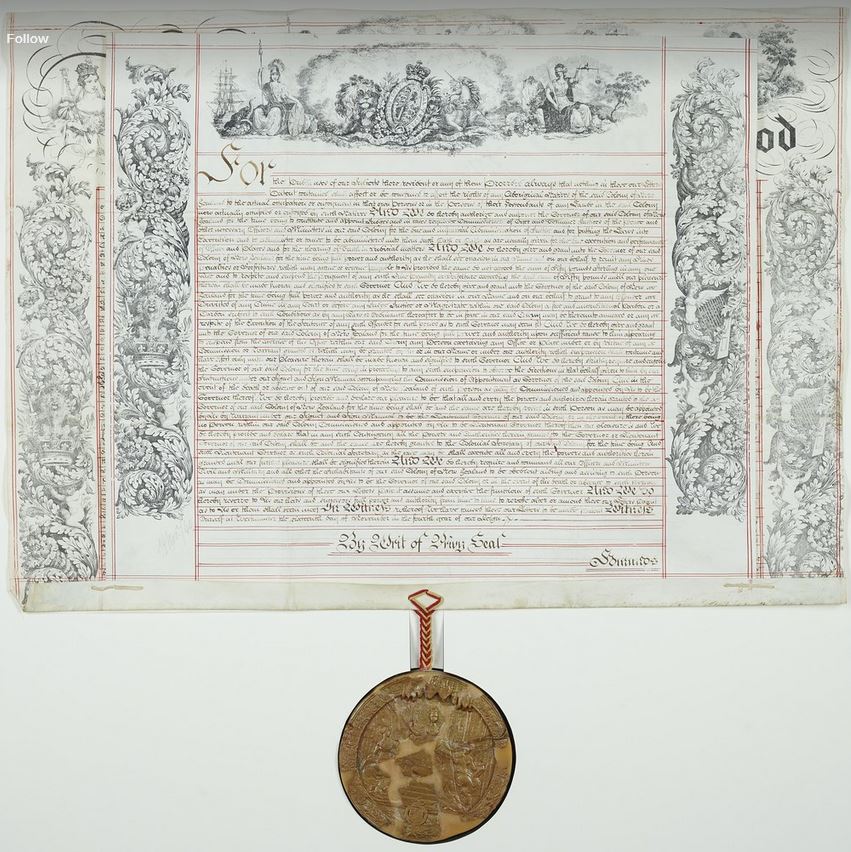
As a result of Hobson’s dispatch to London, dated May 25th 1840, sovereignty over New Zealand was gazetted by Proclamation in London on October 2nd 1840, which triggered Queen Victoria’s Letters Patent of Severance one month later. The British Monarch’s Royal Seal proves that signatures from half the country, and the interior territories, were not considered necessary. Rather, the Signature Tour Rituals were expedient and served mailgn purposes. The Discovery Doctrine stipulated that ‘savage natives’ lacked full sovereign political rights, and therefore those political rights could be diminished incrementally with time, cunning and the implementation of the Doctrine’s elements. Meanwhile, judiciaries treated treaties between a European power and an indigenous peoples as invalid. Therefore, the British Monarch’s Royal Seal was necessary to ensure that no one in the British Esablishment, including the judiciary, questioned the British Crown’s sovereign claim over New Zealand.
Moreover, the 1835 ‘Declaration of Independence’ was a British-led construction to game he tangata o whenua of New Zealand by creating the appearance of a sovereign nation capable of treaty making, to set up Māori for subsequent deconstruction of their sovereign powers and authority – by stealth.
In spite of the 1840 Waitangi Treaty’s pretensions in the preamble that Queen Victoria of the House of Saxe-Coburg and Gotha was evidently anxious to protect the chiefs and the inhabitants of New Zealand from evil, the systematic parallel track screams loud and clear of an exquisitely evil imperial take-over stratagem. Indeed, Lord Normanby’s Instructions to Captain Hobson on 14 August 1839 to construct the extenuating circumstances justifying his Treaty-making mission were written to save face for the British Parliament. As Foden pointed out, treaties between a European Power and an indigenous people could only make it through the courtroom hoop, if a judiciary could be convinced that the particular circumstances were justified. Because there was an obvious unseemly haste and a parallel track of Colonial Law instruments, the pretense of concern for the Aborignees of New Zealand in the preamble would surely have been rather obvious to a bench of judges that an exquisite piece of theatre had been deployed with props of paper, pens and presents to persuade Māori to happily, generously and unreservedly give away their sovereignty forever to a Germanic Queen who had come to England just three years prior, and whom they had never met, and while there was no time to consult, reflect or propose counter-solutions, with the involvement of Māori who lived in the interiors among the highly roastable moa.
Even without being aware that the Treaty spun on the innovative fulcrum of deceptive translation differences, the Treaty would have been deemed null and void in English courts. This is precisely why the Colonial Law Track was laid.
“Ostriches … are not merely careless birds.”
One year after the first Waitangi Treaty signings, missionary Richard Taylor wrote of Chief Nōpera, “now he fears the substance of it will go to [the British] and the shadow only be [the Maori] portion”.
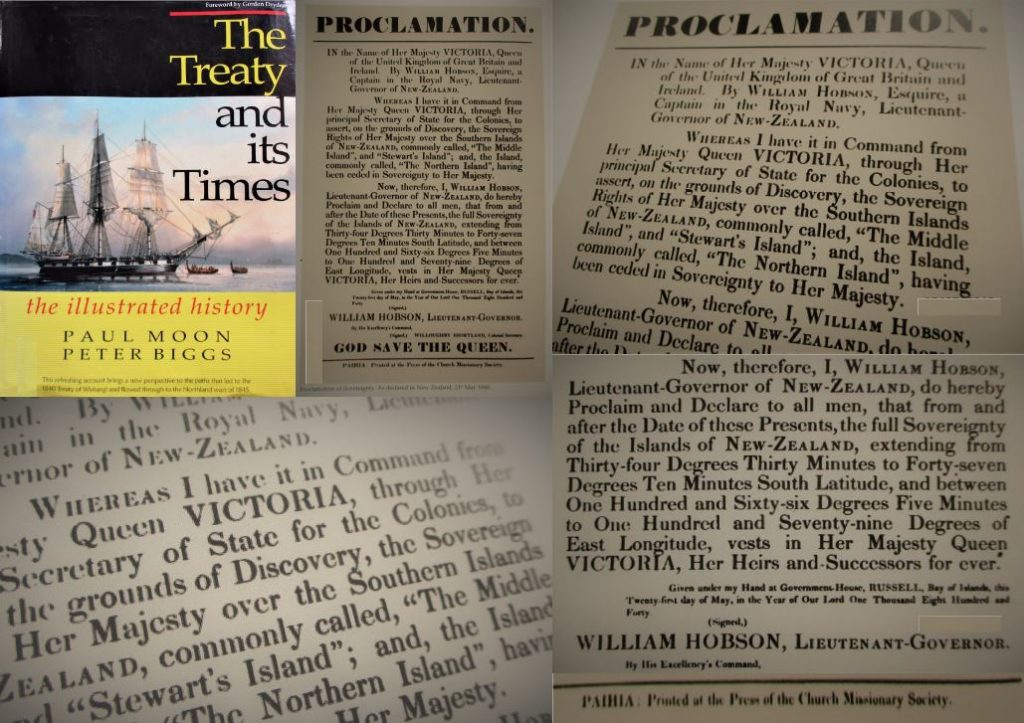
Importantly, most historians, legal scholars and Treaty teachers fail to see the spike in active symbols of Discovery in the form of proclamations, legislation and letters patent produced between from the June 15th 1839 boundary extension of New South Wales and through to May 3rd 1841 – when Captain Hobson performed a vocal symbol oath to declare himself Governor and Commander-in-Chief of the colony – as a crucial parallel track to the Treaty theatrics.
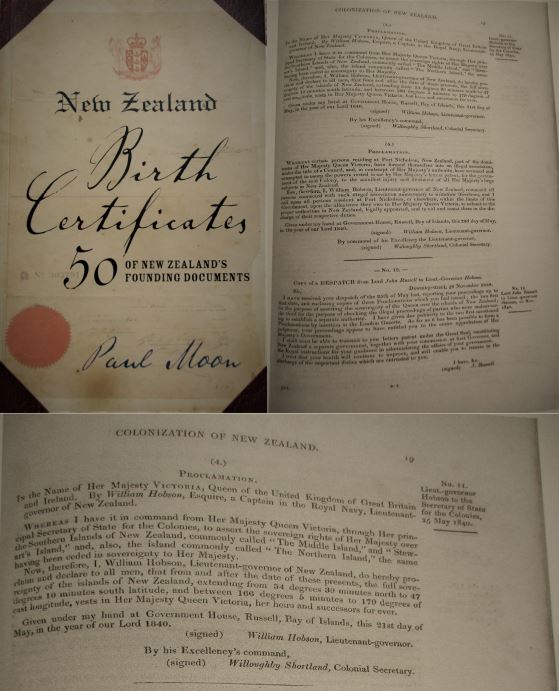
The innovation of the two trick-laden language versions of the 1840 Waitangi Treaty to gain sovereignty over an entire ‘nation’ meant that, in essence, the parchments were spun on a fulcrum that pivoted upon deceptively-crafted translation differences in the texts. By this swindle, a territory the size the Great Britain was gained on the cheap with presents, persuasion and unseemly post-haste. Had the Treaty Cliqué fully disclosed to Māori that they sought to drastically diminish their mana, accumulate their hapū political structures into tribal units for later de-tribalization and transfer their tino rangatiratanga to Queen Victoria, the Treaty Cliqué’s heads would likely have been skewered on sticks at someplace and sometime. Therefore, the fulcrum of deceptive translation differences in the 1840 Waitangi Treaty texts worked to hide the omissions of intent, imperial context, and history.
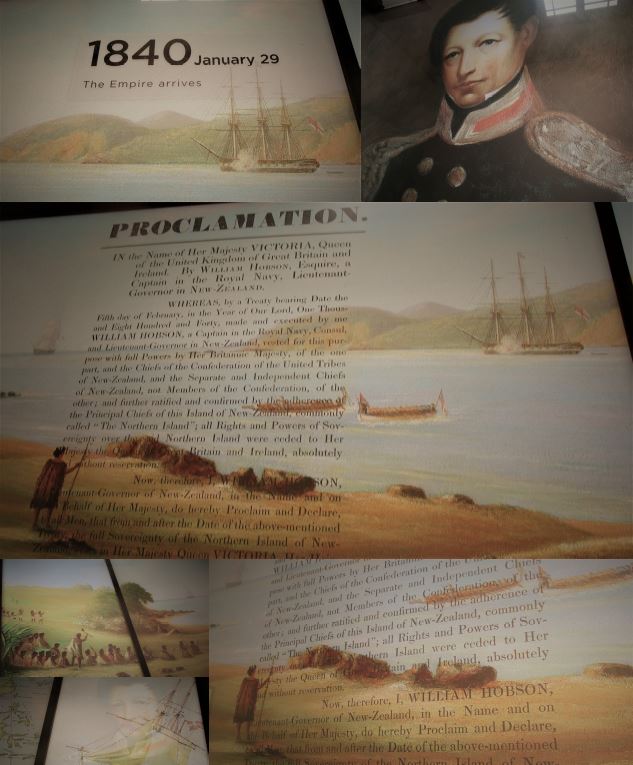
The circumstances, language translation differences and deceptive roles of the Treaty Cliqué were, in fact, the praxis of the Doctrine of Discovery, forged during the Crusades between 1096 and 1271 to justify taking the Muslim-controlled ‘Holy Lands’, and reworked in the 15th Century between the European Maritime Powers to extinguish indigenous sovereign and property rights. This European international law had been designed, agreed and re-negotiated between the European Maritime Powers on rules, rituals and rights for establishing territorial claims in the ‘New World’ to mitigate Europe’s empires fighting one another, while they gained territory off indigenous peoples by swindle, stealth and struggle.
For their part, the British settlers – which included British Protestant missionaries from 1814, and British Resident James Busby, officially-appointed in 1833 – played Māori for time with a series of moves that were, in effect, Discovery Rituals calculated to incrementally wrest sovereignty from Māori without ‘the natives’ fully understanding how exactly it had occurred. This included gaining large parcels of land on a scale comparable to the aristocratic feudal estates in Britain that displaced chiefs who thought they were granting land-use rights to share the territorial resources akin to a rent payment for a lease, rather than a poultry payment for exclusive eternal enjoyment. The beneficiaries of these stealthy land transfers included a former Royal Navy lieutenant appointed as Anglican missionary to the Bay of Islands, Reverend Henry Williams, who along with his Cambridge-educated brother William, worked busily in the 1820s and 1830s saving savage souls and acquiring an 11,000-acre estate in Northland. By swindle and stealth, the Protestant missionaries had gained a foothold while feigning to be friends with ‘the natives’. Furthermore, their participation in moves to coax Māori to participate in the signing the 1831 Letter to King William IV asking for his protection, which made it seem like the act was more an expression of their agency, rather than a trick to invite British Officials to begin an incremental takeover that would buy time before the major chess pieces were required to put-down the inevitable ‘rebellion’ of yet another ‘savage’ race.
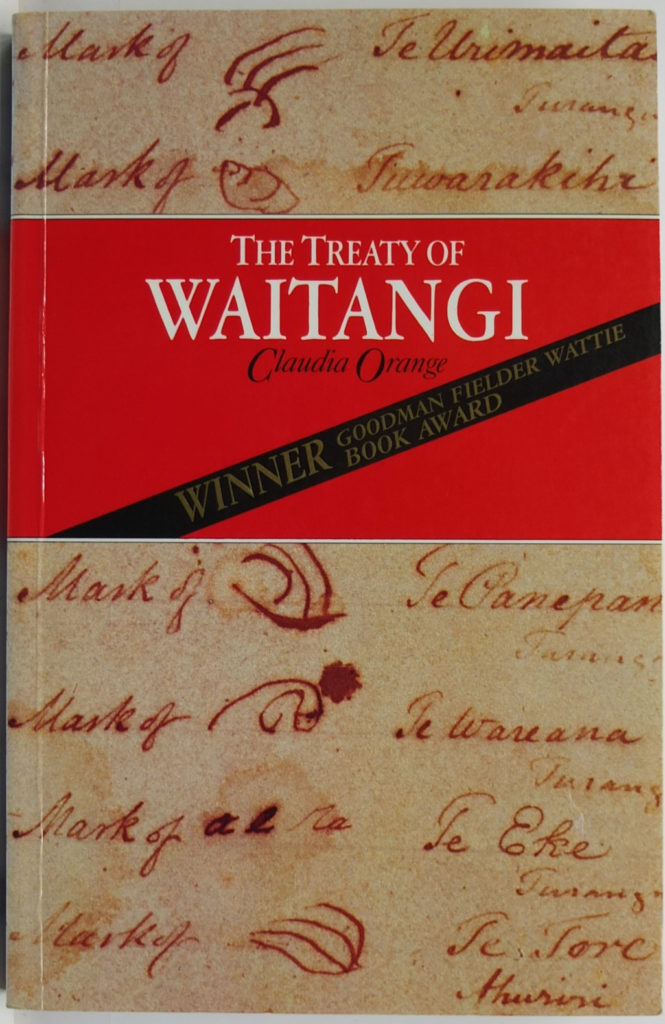
In this view, chief Makoare Taonui deftly grasped the British game play at Mangungu, Hokianga at a Treaty Signing Ritual on 12 February 1840, where 56 chiefs signed after a full days’ debate and decisive assurances from Protestant missionaries that the Treaty would be positive for Māori. Taonui – who had been aboard the Hokianga-built barque, Sir George Murray when it was seized at Port Jackson in 1830 – pointed out that the British Crown had sought by stealth to gradually solidify its position in New Zealand. First, through the presence of the Protestant missionaries, then official British Resident James Busby’s initiative to entice the Māori chiefs to choose a national flag for Māori shipping on 20 March 1834, pacification through gift-giving and then the arrival of Royal Navy Captain William Hobson (1792-1842), as Dame Claudia Orange stated in her seminal 1987 book, The Treaty of Waitangi. In other words, these Discovery Doctrine rituals were anchoring new norms to draw the Māori chiefs incrementally into the British Empire’s jurisdiction.
Whereas, Hobson’s declaration of sovereignty over the South Island and Stewart Island on the grounds of discovery, proves that the parallel track pushed forward was done so in accordance with international law, colonial law and English constitutional law – and were consistent with the Discovery Doctrine.
Because those legal mechanisms were laying the parallel track to forge a colony out of independent Māori nations, and because a treaty between a European Maritime Power and a native race would ordinarily not be accepted in international law, the appearance of cession by treaty hinged upon the innovation of a native-tongue parchment. That way, the Treaty Cliqué could claim the English language version was a copy of the Māori version, thereby reversing its whakapapa.
And, besides God’s ‘men of the cloth’ would not deceive ‘natives’.
Avoiding the C-Word: or the Obtuseness of Historians to Call a Swindle a Conspiracy
In this naïve view, historian Michael Belgrave emphatically stated in Historical Frictions: Maori Claims and Reinvented Histories, it was not in Henry Williams’ character to deliberately deceive the Māori chiefs.
Rather ironically, Belgrave explains away Williams’ failure to use ‘mana’ and ‘rangatiratanga’ to denote sovereignty because, evidently, those words would have been “inappropriate” to describe transference of power. The failure of Williams’ to use his words to describe the stealthy export of sovereign authority is precisely the point that scholars such as Ruth Ross, Ranginui Walker, Anne Salmond, Claudia Orange and Moana Jackson have explained clearly enough.
Tellingly, the Royal Navy captain, as Lieutenant-Governor, proclaimed sovereignty over Te Wai Pounamu on the grounds of Cook’s discovery on 21 May 1840 – before the HMS Herald and Cook Strait treaty copies, with signatures and marks of chiefs from the Middle Island (or South Island), were returned to him. Captain Hobson moved to declare sovereignty over the entire country not simply because the Treaty sheets were taking too long to return. He panicked because he received news that the New Zealand Company settlers had declared a constitutional government at the settlement of Port Nicholson (now Wellington City), which was said to have been ratified by ‘native chiefs’ on March 2nd 1840 – as the Waitangi Tribunal noted in its October 2014 Report, “He Whakaputanga me te Tiriti: the Declaration and the Treaty”. Hobson evidently regarded the settlers moves as “high treason”.
The failure by many historians, legal scholars and Treaty teachers to see the 1840 Waitangi Treaty as theatre to mask the separate track set in motion with Queen Victoria’s Letter Patent to make New Zealand a dependent colony of New South Sales on June 15th 1839 – in effect, renders Captain Hobson’s move to declare sovereignty over the South Island and Stewart Island on the basis of Cook’s Discovery, as simply a curious phenomena – if it gets mentioned. For instance, in his 2018 Waitangi: A Living Treaty historian Matthew Wright noted Captain Hobson’s May 21 1840 declaration claimed the North Island was ceded by treaty while the South and Stewart islands were gained by right of discovery – following the Royal Navy captain learning of the New Zealand’s company’s settlers attempt at Port Nicholson gaining chiefly signatures for their written constitution. Wright downplays the Hobson’s grounds of discovery claim over the South Island and Stewart Island by stating “in some ways it made no great difference because, in general, Major Thomas Brunbury’s efforts aboard the HMS Herald to gain signatures from South Island chiefs, “were dismal”. But, Wright failed to locate his Waitangi: A Living Treaty in the Discovery Doctrine and so he failed to correctly identify the phenomena he was examining. Wright recounts that Reverend Henry Williams’s son, who Edward accompanied Major Brunbury on the mission to treat, ‘jotted the moment in his diary’ when the crew of HMS Herald took possession of Stewart Island, by right of Cook’s discovery:
“… after the men had had their dinner, the officers, and some of the ship’s company, together with the marines, went on shore, and after the proclamation was read and the flag hoisted, the marines fired a feu de joie’ (‘fire of joy’ salute), after which we gave three cheers to the Queen … when the ceremony was over, we rambled about the the bush till three o’clock, and then returned on board … ”
Wright goes on to say that on June 10th 1840, Brunbury sailed to nearby Ruapuke Island where they gained the signature of Chief Tuhawaiki, who was evidently dressed like a British Aide de Camp (or batman to an official, aristocrat or royalty), whom had just returned from Sydney. But because his book is not located in the Discovery Doctrine, power crime theory or the revolutionary dynamic, his readers are not really enlightened to what was really going when he said that with a little over a dozen signatures for the South Island, Major Brunbury declared ‘cession of the Middle Island was completed’ and that he made this declaration of sovereignty across the South Island – unaware of Hobson’s proclamations made five weeks earlier.
But because Wright – like the Waitangi Tribunal and many others, failed to model the British takeover as a crime of power involving deceptive tricks, stratagems and devices – he also failed to detect, code and categorize the phenomena as proofs of conspiracy located in power crime theory. For instance, the journal record of Edward Williams, who co-drafted the Maori text translation from Busby’s English language draft of the Waitangi Treaty, is rife with an account of Discovery possession rituals performed on Stewart Island, in the absence of any Māori.
In The Treaty and its Times, Paul Moon and Peter Biggs printed Hobson’s proclamation claiming sovereignty over the Southern islands of New Zealand “on the grounds of Discovery”, by Proclamation on May 21 1840, as well as in the Great Britain’s Parliamentary Papers. Despite taking Hobson’s phraseology to devote an entire chapter, “On the Grounds of Discovery: Proclamations of Sovereignty” Moon and Biggs claimed in the previous chapter, “Is the Land Not Gone Already: The Treaty of Waitangi”, that New Zealand could not be annexed by right of discovery. To pull off this intellectual gymnastics, they forgo performing scholastic due diligence by failing to properly research the ‘Terra Nullis’ phenomena that they misspelled while they mentioned the doctrine in passing as ‘a land without people’. As the authors of Political Theory and the Rights of Indigenous Peoples, stated, terra nullius was adapted by the European Maritime Powers to inhabitants of the ‘New World’, whom were considered to lack full political rights because they were not Christians busy cutting vast swathes of forests for sheep and cattle to graze and therefore they were deemed too ‘primitive’ to be considered ‘sovereign’.
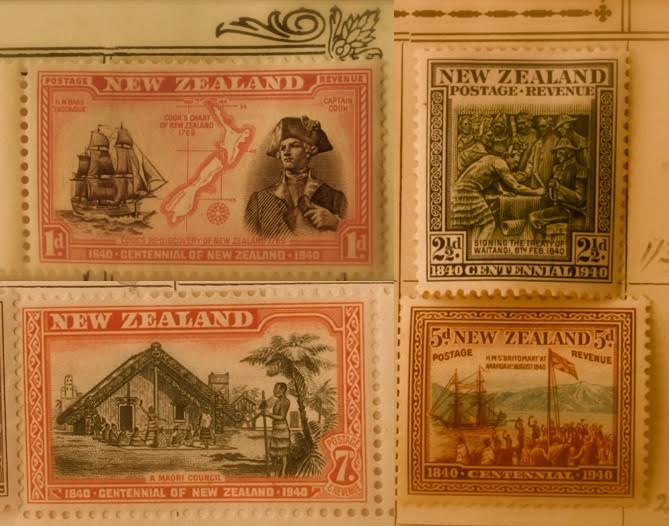
European legal scholars from covetous European nations reworked the Vatican Empire’s terra nullius determining they could also gained property and sovereign rights over ‘undiscovered’ lands and also indigenous peoples upon First Discovery, in territories claimed by a European Catholic Power such as Spain or Portugal.
However, the titles were considered incomplete even if the European nation took possession on paper, following the performance of discovery rituals such as raising flags and claiming the territory for a royal or papal monarch. However, a European Title could only be produced from First Discovery if the European country occupied and possessed their newly found lands within a reasonable period, to complete the annexed title. This often occurred by fort building and establishing settlements.
As Miller wrote in his paper The International Law of Colonialism: A Comparative Analysis, presented at The Future of International Law in Indigenous Affairs in 2012, that terra nullius element of the Discovery Doctrine not only meant lands possessed by no one. Terra nullius also referred to inhabitants lands deemed vacant or waste whenua because Europeans either refused to recognize indigenous forms of land use, customary rights and complex subtle relationships with the whenua. Professor Miller stated that Europeans were very radical and inconsistent in their justifications for applying terra nullius to indigenous occupied lands.
The strength of Robert Miller and Jacinta Ruru comparative analysis of the Discovery Doctrine’s application to gain control over indigenous tribes in United States and New Zealand is that the pattern of the 10 identified elements emerge as evidence of the stealth. Events recounted by historians, as well as new field studies that draw out old anecdotes, can now be coded as stealthy expressions of the Discovery Doctrine. In the New Zealand context, the stealthy legal moves ‘pushed forward’ that were identiifed by Norman Arthur Foden and that have been named by The Snoopman as the Colonial Law Track, can now be coded with the Discovery Doctrine elements.
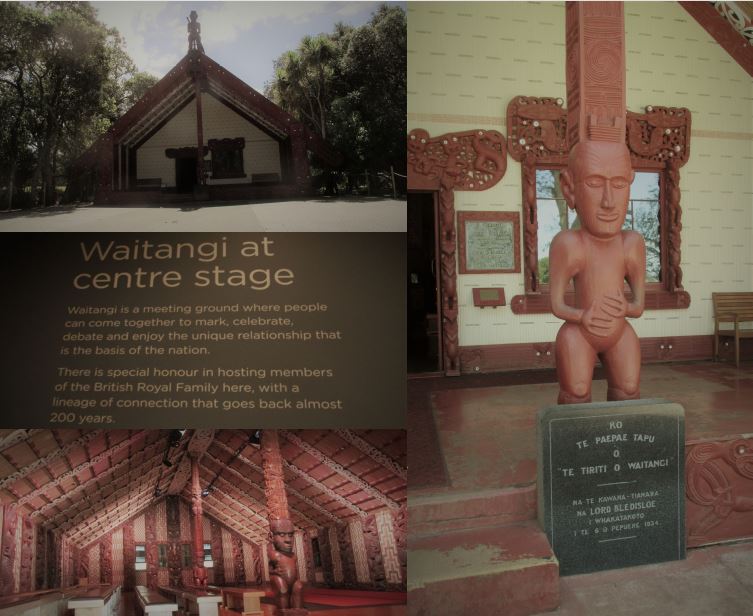
The obtuseness of historians to comprehend this parallel track is remarkable. Richard Hill appears to be the only historian outside of the sub-field of ‘legal history’ whom has cited Foden’s work. Whereas, for instance, in A New Zealand Legal History, Peter Spiller, Jeremy Finn and Richard Boast cite Foden’s two books, they incorrectly claim thecountry’s legal history can be divided into five periods starting with the Crown Colony government (1841-53). They acknowledge that the British originally governed New Zealand from New South Wales, and stated that the Crown’s interests were set in place by legal structures at the outset of the Colony’s history in various official pronouncements in 1839-40, the Treaty of Waitangi itself, the Letters Patent of Severance of November 16th 1840 establishing New Zealand as separate colony and New South Wales and colonial Ordinances enacted in the years 1840-42. In spite of these legal moves, they not only fail to chronicle each of these moves with the others in the series on the Colonial Law Track. In other words, they failed to heed the broad argument of Foden’s book, The Constitutional Development of New Zealand in the First Decade (1839-1849) that there were two ‘legal’ pathways forged by the Crown to gain sovereignty by paper. Spiller, Finn and Boast state that the doctrine of pre-emption underpinned all of these moves, in which “the Crown reserved to itself the right to extinguish Māori customary title to land” and noted this doctrine was written into article two of the Waitangi Treaty and found its way into statute law at the first opportunity (while conspicuously, the Treaty itself was not ratified by legislation). Because the authors of A New Zealand Legal History failed to locate their book in the Doctrine of Discovery, and ignored Foden’s two ‘legal’ pathways thesis, the British Crown’s moves to acquire paper sovereignty over New Zealand are rendered essentially as one track-laying vehicle to construct a colony without any intended deception.
With a failure by New Zealand’s historians, legal scholars and Treaty teachers to firmly anchor their arguments in the British Crown’s stealthily sly application of the Discovery Doctrine to takeover New Zealand by a parallel track, it is not surprisingly then that the Waitangi Museum displays an edited version of Captain Hobson’s Sovereignty Proclamation of May 21 1840. This version of the Church Missionary Society-printed Proclamation, which omits the phrase “on the grounds of Discovery”, is like many artifacts in this museum – a collection that lacks a cohesive, clearly stated position on the British takeover of New Zealand, and therefore reinforces the Myth of Cession (despite a few exhibits and a video presentation that points to the hidden agendas)
In other words, this parallel legal track to the Treaty Signature Rituals – which was first authorized by Queen Victoria’s Letters Patent of Boundary Extension of June 15th 1839 – become a done-deal with Her Majesty’s subsequent royal seal of approval by Letters Patent of Severance on November 6th 1840. At that moment, New Zealand was established as a separate colony from New South Wales with half the country claimed on grounds of Cook’s discovery, while the other half was claimed by construing treaty cession had occurred with the ‘free and intelligent consent’ without acknowledging the in-built weaponization of time to gain new jurisdictional space for the British Masonic Empire.
Indeed, the primary secret mechanism by which the British Empire spread throughout the ‘New World’ was through the secret society of Freemasonry. In turn, Freemasonry was spread mostly through the military regiments, including the navy, as Jessica Harlands-Jacobs stated in her book, Builders of Empire: Freemasonry and British Imperialism, 1717-1927. Harlands-Jacobs, who accessed numerous libraries for her PhD including the British Royal Archives, found that Freemasonry merged with the British Government and the British Monarchy during the 1790s and over a period of three decades re-invented its political leanings and ideology. However, historian Nicholas Hagger – who modelled for the patterns of revolutions, how secret societies plotted them and the reasons for the subterfuge – found in his epic study, The Secret History of the West that this merger occurred in 1717 with the establishment of British Freemasonry’s United Grand Lodge. Thus, Builders of Empire masks how, why and by whom two British Empires were layered.lxviii
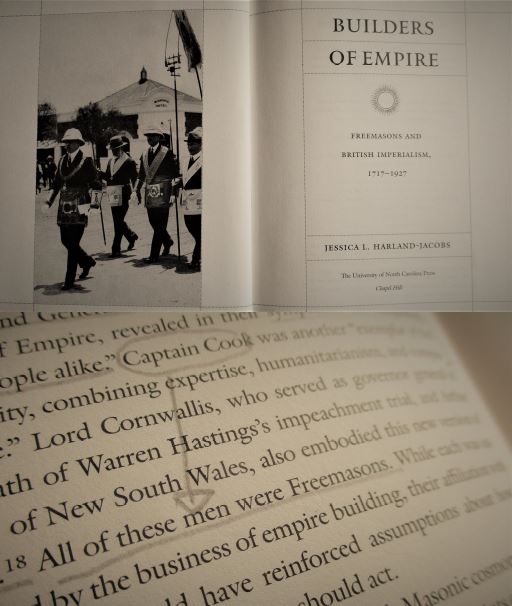
And therein lies the rub.
The British Crown’s bedtime fairy tale nation-creation myth of how and why Māori territories were taken over as a British Masonic Colony in 1839, was deliberate subterfuge to hide how exactly the 1840 Treaty of Waitangi and its derivative Te Tiriti o Waitangi were constructed as deceptive Discovery Doctrine devices. Their purpose was to game Māori, save face for the British Government and trick fair-minded judges.
This fairy tale – known as the myth of cession in Treaty literature, casts Victoria of the Geulph House of Saxe Coburg & Gotha (without usually mentioning her dynastic origins) as a benevolent Queen, who was anxious to ensure evil did not befall the native aborigines of New Zealand. Bestowing the Native Chiefs and Tribes with ‘Her Royal Favour’ – Queen Victoria very generously invited the Aborigines of New Zealand to recognize her Sovereign authority and to cede their sovereignty to Her on the justification that she could not restrain her abundant, troublesome subjects from emigrating, especially those on the independent-minded New Zealand Company’s ships. However, with their willing consent, Her agent, Captain Hobson, could establish Civil Government to check the behaviour of Her British Subjects. As a sweetener for wisely gifting the British Monarch and her heirs all the rights and powers of sovereignty forever – along with a monopoly to buy land they would willingly sell – Her Majesty would confer Māori with all the rights and privileges of British Subjects.
Whereas, Her Majesty never properly explained why would so many British Subjects want to leave if all the rights and privileges of British Subjects were so awesome. Britain, like the other European Maritime Powers, exported its problems abroad. British life was dominated by the British class system, that included the aristocracy’s hold over vast tracts of land, English Rosicrucian Freemasonry’s networked power in commerce, politics and the military, and an economy whose booms, busts and depressions were regulated by the supply of credit, through the privately-owned Bank of England. In light of these key omissions about the controls over ‘British Subjects’ at home, it was under the coercion of weaponized time, persuasive rhetoric and constricted context, that Māori would ‘voluntarily’ give up all the rights and powers of sovereignty – forever.
The perplexing conundrum of why exactly 39 Māori voluntarily and intelligently gave away sovereignty with full consciousness in the English language version, while 492 chiefs and 13 wahine of the total 544 signers retained their sovereignty in the Māori language version – Te Tiriti o Waitangi – are revealed as the result of a power crime perpetrated by a Treaty Cliqué.
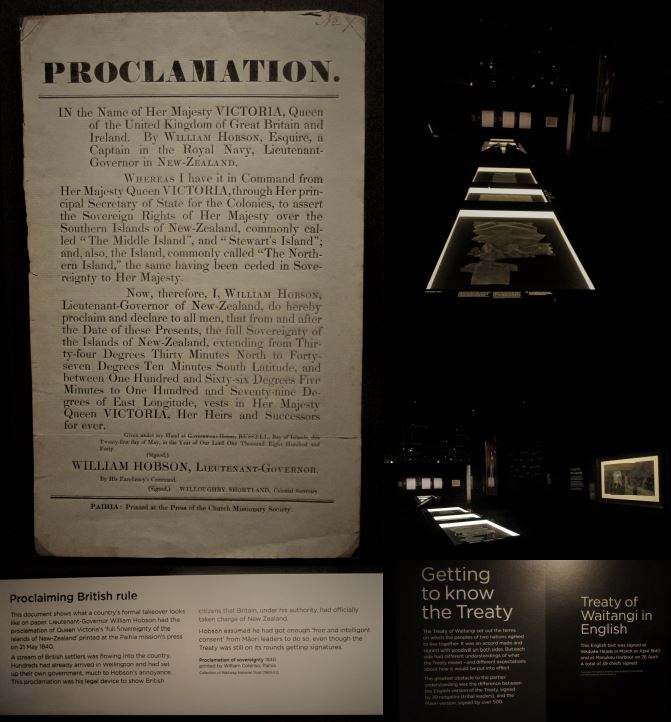
Betwixt the spiraling momentum of deception in the unfolding events of 1839 and 1840 – that were embedded with weaponized speed – the Treaty Cliqué raced toward the endgame by controlling time: capturing political space via the appearance of a paper sovereignty payload.
“Ostriches … are not merely careless birds.”
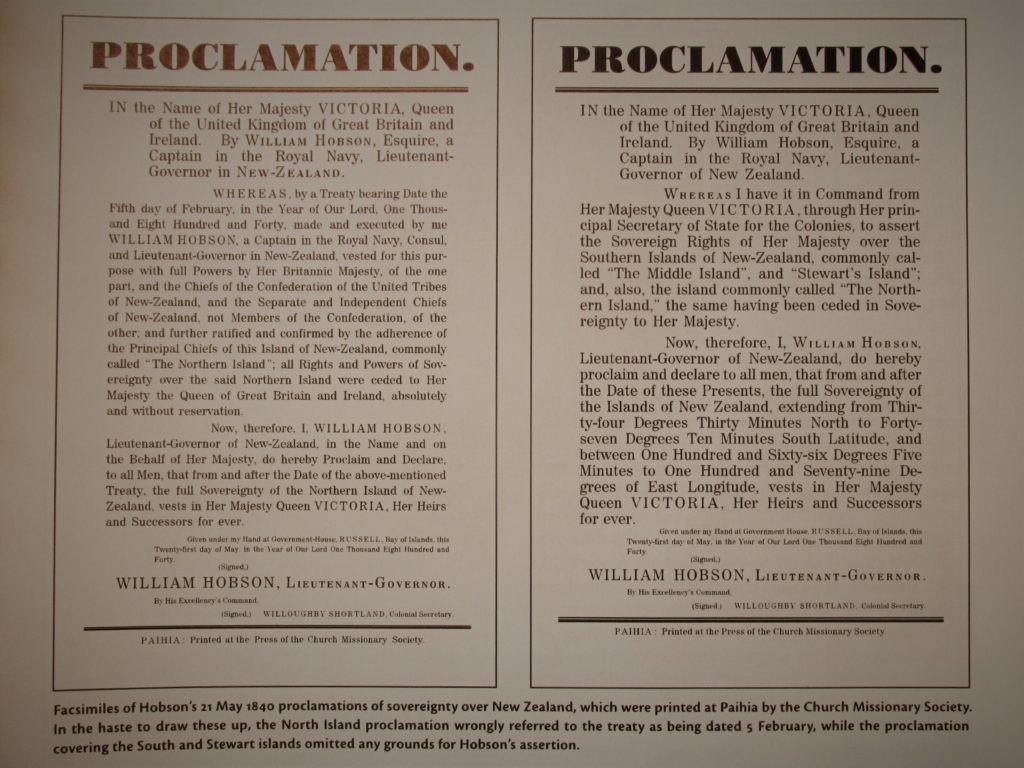
To sum up, the crime was ‘scripted’, ‘committed’ and ‘improvised’ by the hands, tongues and ‘sincere’ face-masks of the Treaty Cliqué. They failed to divulge that the 1840 Treaty and te Tiriti o Waitangi parchments were deceptive devices to advance the British Masonic Empire’s Doctrine of Discovery praxis.
The British Crown played a stealthy game of annexation to gain sovereign authority over New Zealand to seal its claims of ‘discovery’. By scheming, improvising and performing from a ‘tool-kit’ of measures and at every move deploying subterfuge, the British made in-roads to anchor new norms among a people considered uncivilized, barbarous and unworthy of full disclosure. The British Crown exploited the speed of unfolding events to win jurisdiction, thereby doubling-down to gain control over political space by weaponizing time. The British construed that its ‘Royal Hand’ has been ‘forced’ by the New Zealand Company’s outrageous move in sending three immigrant-laden ships in 1839 to gain ‘titles’ by swindle. Yet, if it cared – as it pretended – about another indigenous people being exploited, dispossessed and run roughshod over, it could have sent military ships to intervene. But, the British Crown did not send numerous military ships, partly because the Royal Navy ships were needed elsewhere, not insignificantly because Lord Palmerston was simultaneously ‘lining up his ducks’ to trigger the First Opium War as a long-game to gain footholds in China. And also, because it would have signalled to all the other empire’s that the British Masonic Oligarchy’s appetite for imperial expansion had faltered at a time when Lord Palmerston was supposed to be High Priest of all Secret Societies.
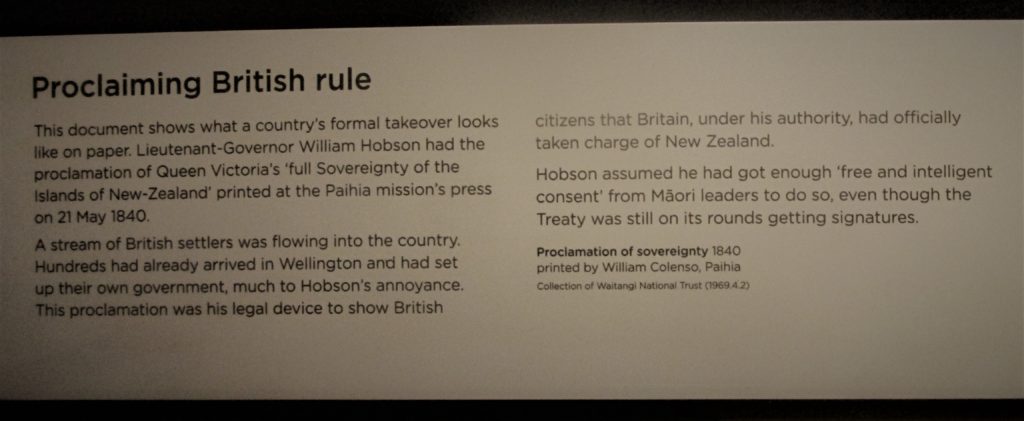
The Parchment Signing Rituals were a manifestation of the element of Preemption/European Title wherein speed was weaponized to gain jurisdictional space, despite the British Masonic Empire having no legitimate right to control Maoriland. In other words, the urgency to trick Māori into appearing to cede sovereignty in a compressed time compelled the ‘need’ for a Treaty Cliqué to form a plot, rather than the affair being simply a series of mistakes, thoughtlessness and callous individual agendas culminating in ‘translation errors’, positively spun explanations, and a clichéd well-intended British cock-up.
Key Finding: The British takeover of Aotearoa by two parallel tracks – a ‘Treaty Theatre Track’ and a ‘Colonial Law Track’ – were innovative cunning tricks in statecraft to gain full sovereignty over an entire indigenous people that could never be repeated, lest the perfect crime became obvious.
The ‘Treaty Theatre Track’ was essentially laid from June 1831, when James Busby published a policy proposal for a British Official to make treaties with Māori in his “Memoir Relative to the Islands of New Zealand”, and was followed by the ‘Letter to King William IV of October 5 1831’ signed by 13 rangatira. This ‘Treaty Theatre Track’ was advanced by gaining the participation of Māori to choose the Te Kara shipping flag in 1834, to sign a ‘Declaration of Independence’ in 1835. More Treaty track was laid by Captain Hobson’s Factory System plan of 1837 which proposed a treaty for settlements. Then, in 1840, the Treaty Cliqué construed with the English language version, that the Treaty Chiefs had freely and consciously ceded sovereignty.
Meanwhile, when the Queen Victoria-approved Letters Patent of Boundary Extension, dated June 15 1839, brazenly expanded the jurisdiction of New South Wales to include New Zealand, the Monarch initiated the final stage of the ‘Colonial Law Track’. This Colonial Law Track had been set in motion by the King George III-sponsored Endeavour Voyage that resulted in Captain James Cook creating an incomplete annexed title, when he claimed possession of New Zealand in 1769 and 1770. Queen Victoria sealed the completion of the takeover of New Zealand when she signed the Royal Charter for Severance on 16th November 1840, thereby erecting N.Z. as a separate colony.
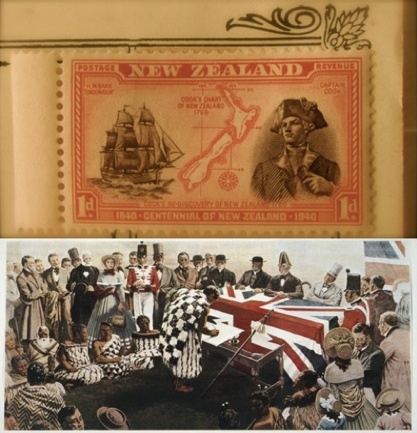
The Discovery Doctrine, which was ‘transported’ on both parallel tracks – the shorter ‘Treaty Theatre Track’ first laid in 1831 by James Busby and a ‘Colonial Law Track’ first laid in 1769-1770 by Captain Cook – actually ‘intersected’ at Waitangi and other signing places. Prior to, during and after the Treaty signings, the letters patents, proclamations, new commissions, and legislation were like ‘switches’ to the new Colonial Law ‘track’ that would enable Britain to gain supremacy without these tricks being comprehensible to Māori at the time – even if they learned of some of them.
At Waitangi, time had been weaponized to gain control over a new territorial-jurisdictional space for the British Masonic Empire. Therefore, the ‘Endeavour Voyage’ in 1769-1770 was New Zealand’s first travelling theatre and the Waitangi Treaty Theatre was the second major staged production conjured to distract, divide and defeat. Like all criminal plots, not everything went according to plan. The three clanker moments during Waitangi Treaty Theatre required improvizational theatre to mask the deceptions in play. Had any one those three clanker moments escalated into full disclosure, the ruse would have been up.
The innovative the trick of of gaining full sovereignty on paper over an entire indigenous people – with language translation deceptions – could only work once. Because if this innovative trick were ever repeated, the cover-story of a hastily-drafted treaty in a far-flung location amid pressure of immigrant-laden ships, land speculating syndicates, and the perennial French bogeyman showing up – would have blown up in the British Establishment’s properly-mannered faces.
Therefore, the British takeover of New Zealand by two parallel tracks – a ‘Treaty Theatre Track’ and a ‘Colonial Law Track’ – were innovative cunning tricks in statecraft to gain full sovereignty over an entire indigenous people that could never be repeated, lest the perfect crime became obvious. This truth has been concealed because the profundity of its impacts remain far-reaching, deep and brutal.
“Ostriches … are not merely careless birds.”
Editor’s Note: If we have made any erros, please contact our intern, Steve Edwards. e: steveedwards555[at]gmail.com
i Anne Salmond. (2017). Tears of Rangi: Experiments Across Worlds, p.248. Auckland University Press.
ii Snoopman. (December 7, 2019). Crown Contrived Ignorance: The NZ Govt’s Reckless Refusal to Admit 1840 Treaty Trick while Gaming Ngāpuhi to Settle & Cede. https://snoopman.net.nz/2019/12/07/crown-contrived-ignorance-the-nz-govts-reckless-refusal-to-admit-1840-treaty-trick-while-gaming-ngapuhi-to-settle-cede/
iiiWaitangi Tribunal. (October 2014). He Whakaputanga me te Tiriti: the Declaration and the Treaty. Retrieved from: www.waitangitribunal.govt.nz; The Waitangi Tribunal’s findings are consistent with Ngāpuhi Speaks, published in 2012. See: Te Kawariki & Network Waitangi Whangarei. (2012). Ngāpuhi Speaks: He Whakaputanga o te Rangatiratanga o Nu Tireni and Te Tiriti o Waitangi. Ngāpuhi Nui Tonu Claim. Commissioned by Kuia and Kaumātua of Ngāpuhi.
ivEmily Blincoe. (2015). “The Myth of Cession: Public Law Textbooks and The Treaty of Waitangi”, p. 8-9. Faculty of Law, Victoria University. Retrieved from: http://researcharchive.vuw.ac.nz/xmlui/bitstream/handle/10063/5021/paper.pdf?sequence
vWorried Māori chiefs voiced their concerns. Ngāi Tawake rangatira Rewa spoke prophetic insights when he said, “What do Native men want of a Governor? … Send the man away; do not sign the paper; if you do you will be reduced to the condition of slaves, and be obliged to break stones for the roads. Your land will be taken from you, and your dignity as chiefs will be destroyed.” Excerpt of kōrero. Waitangi Treaty hui of February 5 & 6, 1840. As cited In: Waitangi Tribunal. (October 2014). He Whakaputanga me te Tiriti: the Declaration and the Treaty, p. 358.
viHarnessing the Herd to Hide a Historical Heist. https://snoopman.net.nz/2018/09/18/harnessing-the-herd-to-hide-a-historical-heist/
viiWaitangi Investigation: Steve Edwards – Harnessing the Herd to Hide a Historical Heist: The Crown’s breach of the Crimes Act https://thedailyblog.co.nz/2018/02/06/waitangi-investigation-steve-edwards-harnessing-the-herd-to-hide-a-historical-heist-the-crowns-breach-of-section-the-crimes-act/
viiiLandlord Possession Rituals of Prince Charles. https://snoopman.net.nz/2019/11/24/landlord-possession-rituals-of-prince-charles-part-i/?fbclid=IwAR3OpLjLzU_qb2bFfI6UrG3rRg4mqJhLZAxPncZjT_QW-gOPuN9gInArBjM
ixSteve ‘Snoopman’ Edwards. (25 April 2017). “The Masonic New Zealand Wars”. Retrieved from:
The Masonic New Zealand Wars: Freemasonry as a Secret Mechanism of Imperial Conquest During the ‘Native Troubles’
xDavid Luban. (2007). Legal Ethics and Human Dignity. Cambridge Studies in Philosophy and Law. https://static1.squarespace.com/static/58d6b5ff86e6c087a92f8f89/t/593dfef59de4bbf286f362c8/1497235211718/David+Luban+Legal+Ethics+and+Human+Dignity+Cambridge+Studies+in+Philosophy+and+Law++2007.pdf; David Luban. (1999). “Contrived ignorance”. The Georgetown Law Journal. https://scholarship.law.georgetown.edu/cgi/viewcontent.cgi?article=2765&context=facpub
xi Wilson, E. (2009). Speed/pure war/power crime: Paul Virilio on the criminogenic accident and the virtual disappearance of the suicidal state. Crime, Law & Social Change, 51, 413-434. doi:10.1007/s10611-008-9168-7
xiiVincent O’Malley. (2014). Beyond the Imperial Frontier: The Contest for Colonial New Zealand, p. 39
xiiiSamuel D Carpenter. (November 2009). Te Wiremu, Te Puhipi, He Wakaputanga Me Te Tiriti – Henry Williams, James Busby, A Declaration And The Treaty, p.16-17. Report commissioned by the Waitangi Tribunal. Retrieved from https://forms.justice.govt.nz/search/Documents/WT/wt_DOC_1734955/Wai%201040%2C%20A017.pdf
xiv J. I. Hetherington. (1926). New Zealand: Its Political Connection with Great Britain, Volume I, p. 75. Dunedin: New Zealand: Coulls, Somerville Wilkie.
xvWaitangi Tribunal. (October 2014). He Whakaputanga me te Tiriti: the Declaration and the Treaty. Retrieved from: www.waitangitribunal.govt.nz
xvi Salmond. (2017). Tears of Rangi: Experiments Across Worlds. p. 215-217.
xvii Manuka Henare, Dr Angela Middleton and Dr Adrienne Puckey. (21st February 2013). “He Rangi Mauroa Ao te Pö: Melodies Eternally New”. Te Aho Claims Alliance (TACA): Oral and Traditional History Project Number: 23161.001. Mira Szászy Research Centre, The University of Auckland Business School. Retrieved from https://forms.justice.govt.nz/search/Documents/WT/wt_DOC_50129548/Wai%201040,%20%23E67.pdf
xviiiCarpenter. (November 2009). Te Wiremu, Te Puhipi, He Wakaputanga Me Te Tiriti – Henry Williams, James Busby, A Declaration and The Treaty, p.16.
xix Salmond. (2017). Tears of Rangi: Experiments Across Worlds. p. 226-227.
xx Hetherington. (1926). New Zealand: Its Political Connection with Great Britain, p. 75.
xxiCarpenter. (November 2009). Te Wiremu, Te Puhipi, He Wakaputanga Me Te Tiriti – Henry Williams, James Busby, A Declaration And The Treaty, p.16.
xxii Hetherington 1926 p. 94
xxiii Salmond. (2017). Tears of Rangi: Experiments Across Worlds. p. 234.
xxiv Hetherington 1926, p. 94
xxv– Waitangi Tribunal Report 2014 p. 129
xxviManuka Henare, Dr Angela Middleton and Dr Adrienne Puckey. (21st February 2013). “He Rangi Mauroa Ao te Pö: Melodies Eternally New”, p. 205. Mira Szászy Research Centre, The University of Auckland Business School. Retrieved from https://forms.justice.govt.nz/search/Documents/WT/wt_DOC_50129548/Wai%201040,%20%23E67.pdf
xxviiAnne Salmond. (2017). Tears of Rangi: Experiments Across Worlds, p. 234-235.
xxviii Waitangi Tribunal Report 2014, p. 131.
xxix Von Huegel Diaries quoted in: Waitangi Tribunal Report 2014, p. 131.
xxxWaitangi Tribunal Report 2014, p. 130.
xxxi William Barrett Marshall. (1836). A Personal Narrative of Two Visits to New Zealand in His Majesty’s Ship, Alligator, A.D. 1834, p.107-111. London James Nisbet & Co. Retrieved fromhttp://www.enzb.auckland.ac.nz/document/?wid=402&page=0&action=null; J. H Wallace. (1890). The Early History of New Zealand: From the Earliest Times to 1840, p. 432-433.
xxxiiAnne Salmond. (2017). Tears of Rangi: Experiments Across Worlds, p. 234-235.
xxxiiiThe Flemish force wore green crosses. See: Ottfried Neubecker. (1976). Heraldry: Sources, Symbols and Meaning. p. 66-67. Maidenhead, England: McCraw-Hill.
xxxivRobert J. Miller. (2012). THE INTERNATIONAL LAW OF COLONIALISM: A COMPARATIVE ANALYSIS, p. 855-856. The Future of International Law in Indigenous Affairs: The Doctrine of Discovery, the United Nations, and the Organization of American States SYMPOSIUM. Lewis & Clark Law Review.
xxxvMiller, Robert J. & Ruru, Jacinta. (2009). An Indigenous Lens into Comparative Law: The Doctrine of Discovery in the United States and New Zealand, Vol. 111, 849-918. West Virginia Law Review.
xxxviWaitangi Tribunal. (October 2014). He Whakaputanga me te Tiriti, p.133.
xxxvii Vincent O’Malley. (2014). Beyond the Imperial Frontier, p. 41; Anne Salmond. (2017). Tears of Rangi, p. 239.
xxxviiiTe Kawariki & Network Waitangi Whangarei. (2012). Ngāpuhi Speaks: He Whakaputanga o te Rangatiratanga o Nu Tireni and Te Tiriti o Waitangi. Ngāpuhi Nui Tonu Claim, p 59. Commissioned by Kuia and Kaumātua of Ngāpuhi.
xxxixWaitangi Tribunal. (October 2014). He Whakaputanga me te Tiriti, p.136.
xl Henare, Middleton and Puckey. (21st February 2013). “He Rangi Mauroa Ao te Pö: Melodies Eternally New”, p. 210.
xliTe Kawariki & Network Waitangi Whangarei. (2012). Ngāpuhi Speaks, p. 59.
xliiWaitangi Tribunal. (October 2014). He Whakaputanga me te Tiriti, p. 168
xliiiMatthew S. R. Palmer. (2008). The Treaty of Waitangi in New Zealand’s Law and Constitution, p. 45. Wellington, New Zealand: Victoria University Press.
xlivMatthew S. R. Palmer. (2008). The Treaty of Waitangi in New Zealand’s Law and Constitution, p. 45. Wellington, New Zealand: Victoria University Press.
xlvCarpenter. (November 2009). Te Wiremu, Te Puhipi, He Wakaputanga Me Te Tiriti – Henry Williams, James Busby, A Declaration And The Treaty, p.48.
xlvi Salmond. (2017). Tears of Rangi, p.244
xlviiMatthew S. R. Palmer. (2008). The Treaty of Waitangi in New Zealand’s Law and Constitution. Victoria University Press.
xlviiiDom Felice Vaggioli. (2000 [1896]). History of New Zealand and its Inhabitants, Vol. II. Dunedin, NZ: University of Otago Press; Tony Simpson (1986). Te Riri Pakeha: The White Man’s Anger. Auckland, NZ: Hodder and Stoughton; James Belich (1998). The New Zealand Wars: And the Victorian View of Racial Conflict.
xlixThe Masonic New Zealand Wars: Freemasonry as a Secret Mechanism of Imperial Conquest During the ‘Native Troubles’. Retrieved from https://snoopman.net.nz/2017/04/25/the-masonic-new-zealand-wars/
l Matthew Wright. (2019). Waitangi: A Living Treaty, p. 18.
liThe English language version was wrongly registered in London on 15 October 1840 as a translation of the Māori language version. Claudia Orange. (1987). The Treaty of Waitangi, p. 85.
liiRev Henry Williams was well aware of the imperfections in the translation. “If Williams had used the terms ‘ko te kingitanga ko te mana’ (as he did in He Wakapūtanga) to translate ‘sovereignty’ in Ture 1 of te Tiriti, and asked the rangatira to cede these powers to the British Crown, it is almost certain that they would have been angry and affronted, and that the negotiations would have failed. Instead, he couched the cession to Queen Victoria as a tuku or release of ‘kāwanatanga”, stated Anne Salmond. Waitangi Tribunal. (October 2014). He Whakaputanga me te Tiriti: the Declaration and the Treaty, p. 464. Moreover, the comparative shortness of the First and Second Articles in the Māori version shows the inadequacy since Māori translations of English uses more words.
liii Emily Blincoe. (2015). “The Myth of Cession: Public Law Textbooks and The Treaty of Waitangi”, p. 8-9. Faculty of Law, Victoria University. Retrieved from: http://researcharchive.vuw.ac.nz/xmlui/bitstream/handle/10063/5021/paper.pdf?sequence
liv Keith C. Hooper and Kate Kearins. (November 1, 2003). “Substance but not form: capital taxation and public finance in New Zealand, 1840-1859”. Retrieved from https://doi.org/10.1177/103237320300800206
lvAnne Salmond. In: Waitangi Tribunal. (October 2014). He Whakaputanga me te Tiriti.
lvi The Waitangi Tribunal’s findings are consistent with Ngāpuhi Speaks, published in 2012. See: Te Kawariki & Network Waitangi Whangarei. (2012). Ngāpuhi Speaks: He Whakaputanga o te Rangatiratanga o Nu Tireni and Te Tiriti o Waitangi. Ngāpuhi Nui Tonu Claim. Commissioned by Kuia and Kaumātua of Ngāpuhi.
lviiClaudia Orange. (1987). The Treaty of Waitangi, p. 81. Wellington, New Zealand: Allen & Unwin Port Nicholson Press.
lviiiMark Hickford. (2011). Lords of the Land: Indigenous Property Rights and the Jurisprudence of Empire, p. 102. Oxford University Press.
lix Peter Low (2011). Bishop Pompallier and Te Tiriti. In: The French Place in the Bay of Islands, p. 122. Mātou Matauwhi.
lxAnne Salmond (2017). Tears of Rangi, p. 205-206.
lxi Vincent O’Malley. (2014). Beyond the Imperial Frontier, p. 144, 146.
lxiiFletcher, Ned; Elias, Rt Hon Dame Sian — “A Collusive Suit to ‘Confound the Rights of Property Through the Length and Breadth of the Colony’?: Busby v White (1859)”. [2010] VUWLawRw 30; (2010) 41(3) Victoria University of Wellington Law Review 563 Retrieved from http://www.nzlii.org/nz/journals/VUWLawRw/2010/30.html
lxiii The Snoopman. (December 3, 2019). Royal Landlord Possession Rituals. https://snoopman.net.nz/2019/12/03/royal-landlord-possession-rituals/
lxivRichard S. Hill. (1986). Policing the Colonial Frontier: The Theory and Practice of Coercive Social and Racial Control in New Zealand, 1767-1867– Part One, p. 88-90. Wellington, New Zealand: Historical Publications Branch Department of Internal Affairs
lxvN. A. Foden. (1938). Constitutional Development of New Zealand in the First Decade (1839-1849). Wellington, New Zealand: L. T. Watkins Ltd.
lxviJ. I. Hetherington also stated in New Zealand: Its Political Connection with Great Britain Volume I, that in a Return of 20th February 1845, listing colonies of the British Empire, New Zealand’s entry stated the country was “Acquired by Settlement , 1839”. p. 139.
lxviiN. A. Foden.(1965). New Zealand Legal History (1642-1842). Wellington, New Zealand: Sweet & Maxwell (N.Z.) Ltd.
lxviii Builders of Empire is a propagandist work that takes its audience down an identity politics sidetrack to show how Freemasons lived up to their cosmopolitan ideology when it came to inclusiveness toward indigenous peoples and former slaves in the colonies, or in their exclusion of women and Catholics from Freemason lodges in the 130 year period of imperial expansionism examined.

